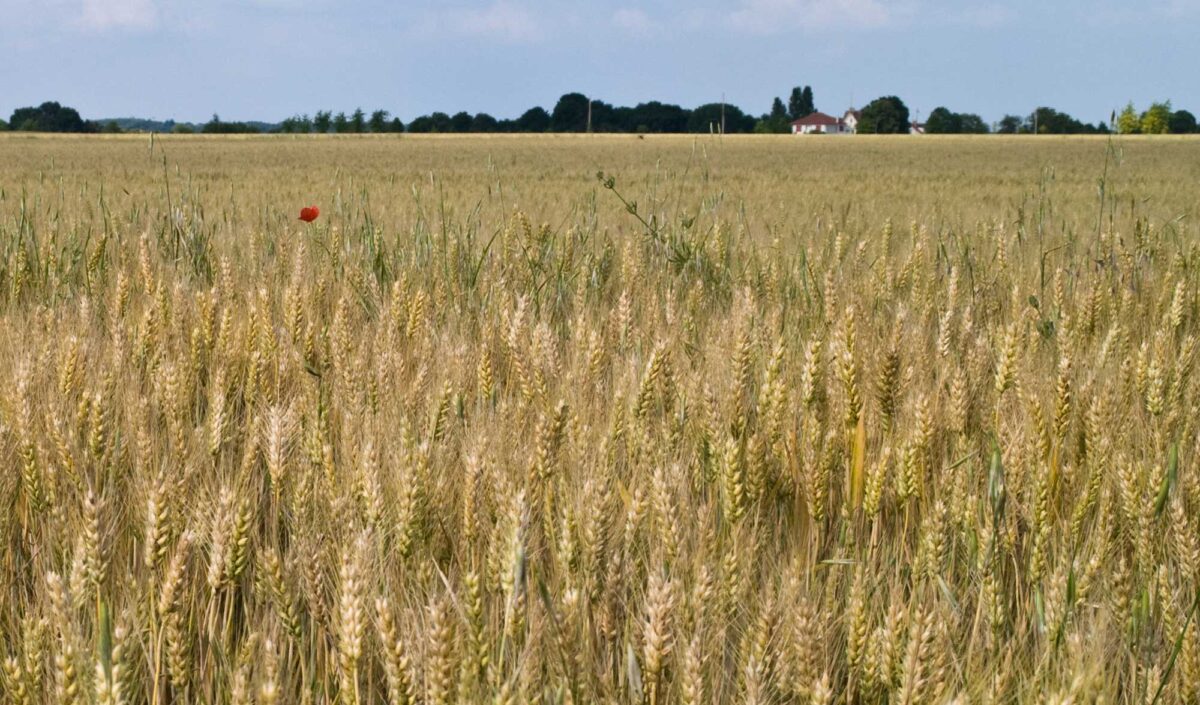Page snapshot: Overview of cereals, including the parts of a cereal, types of domesticated cereals, processing grain from cereals, and characteristics that changed during domestication of cereals.
Topics covered on this page: Introduction; Cereals as food; Parts of a cereal; Cereals and human nutrition; Refined cereals and nutrition; Fortified (enriched) cereals; Types of cereals; Maize (corn); Wheat, barley, rye, and triticale; Rice; Sorghum; Millet; Oats; Processing grain from cereals; Threshing; Husking (hulling, shucking); Winnowing; Grinding; Domestication; Stem structure; Seed dormancy; Seed dispersal; Grain size; Ease of processing; List of cereals; Resources.
Credits: Funded by the National Science Foundation. Any opinions, findings, and conclusions or recommendations expressed in this material are those of the author(s) and do not necessarily reflect the views of the National Science Foundation. Page by Elizabeth J. Hermsen (2022).
Updates: Page last updated August 23, 2023.
Image above: A wheat field in Seine-et-Marne, France. Photo by Myrabella (Wikimedia Commons, Creative Commons Attribution-ShareAlike 3.0 Unported license, image cropped and resized).
Introduction
Cereal crops are grown for their fruits, called grains. A cereal is an edible grain that comes from a grass. The term cereal also means a grass that produces edible grain.
Cereals were some of the first plants to be domesticated, and different types of cereals were domesticated in different parts of the world. Many cereals that are globally important crops, like barley and wheat, originated in the Middle East, whereas rice comes from China, and maize (corn) from Mexico. Many other regionally important cereals were domesticated and are primarily cultivated in Africa and Asia. These more obscure cereals are of great interest today as alternatives to some of the more widely cultivated grains, because they can often be grown in hotter and drier conditions and on land considered marginal for agriculture.
Many of the world's cereals are grown for food for domesticated animals and for humans. Some cereals, particularly barley, are used in brewing beer and making spirits. Cereals may also be grown for a variety of other uses.

Winnowing millet, Senegal. Photo by Fischerij360 (Wikimedia Commons, Creative Commons Attribution-ShareAlike 4.0 International license, image resized).
Cereals as food
Parts of a cereal
A cereal is a caryopsis or grain. Botanically, grains are a type of fruit, although most of the tissue in a grain comes from the seed, and the fruit wall is very thin. In cultivated cereals, groups of fruits (really, inflorescences or groups of spikelets) are often called ears.
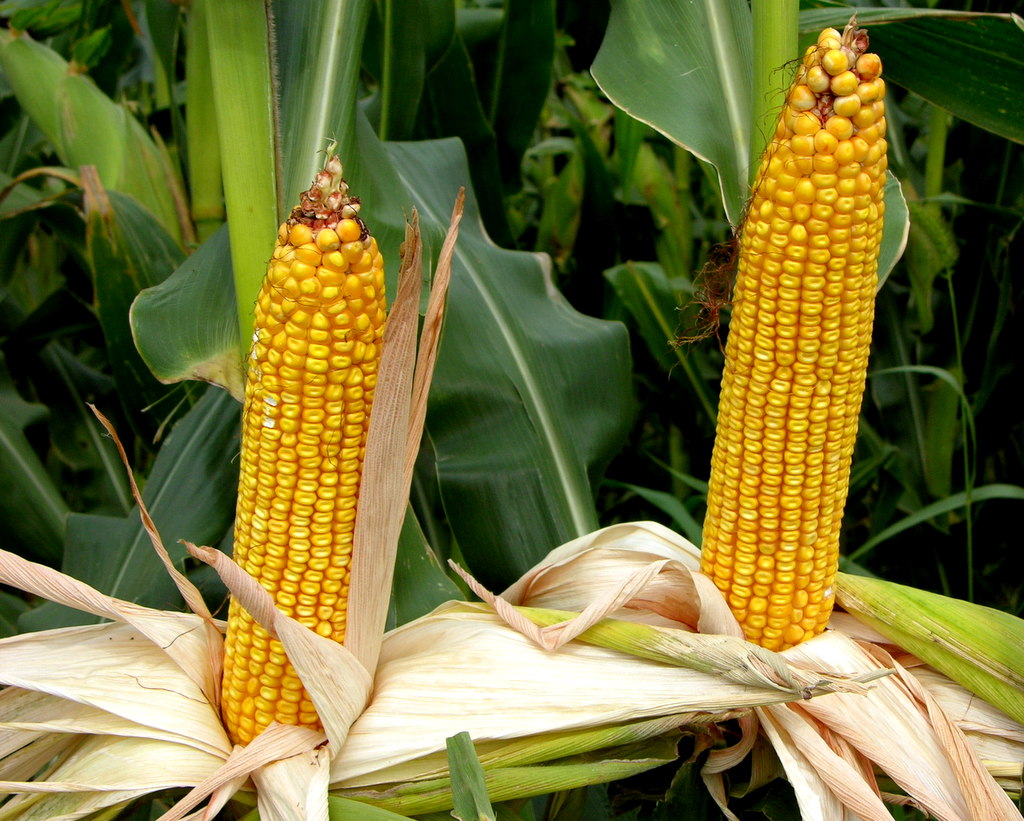
Ears of maize (Zea mays), Missouri, U.S.A. "Corn ears," photo by Phil Warren (flickr, Creative Commons Attribution 2.0 Generic license).
A grain consists of multiple parts that are important for providing humans and animals with energy and nutrients. The outer covering of a grain is the bran. The bran includes the fruit and seed walls and the aleurone layer within them. Within the grain is the embryo, called the germ, and the endosperm, which is a starchy tissue intended to provide nutrition to the embryo when the grain germinates.
Note: Botanically, the aleurone layer is part of the endosperm because, like the starchy endosperm tissue, it develops from the primary endosperm nucleus in the immature seed. In the context of grain processing, however, the aleurone layer is considered to be part of the bran.
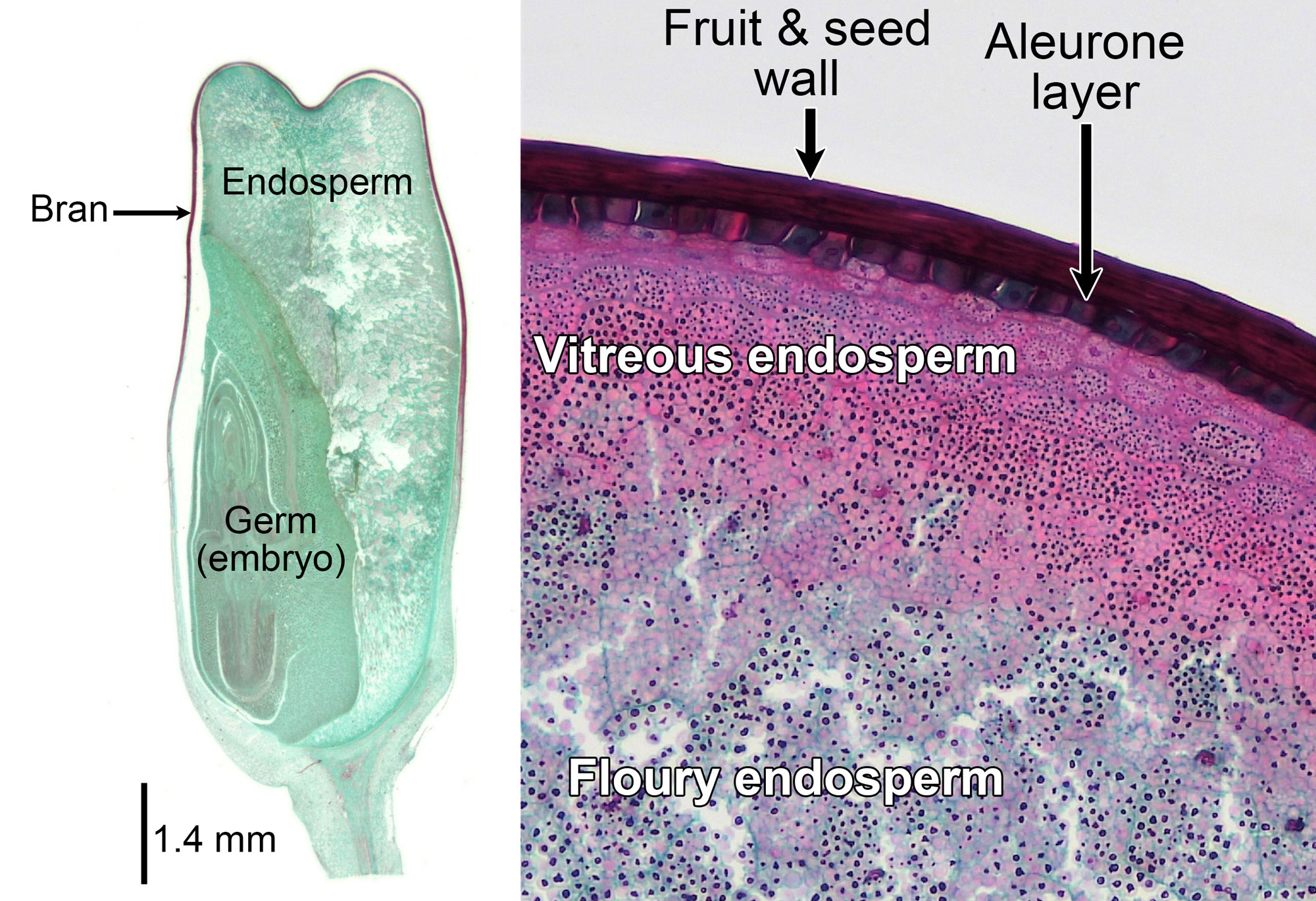
Grain of maize (Zea mays). Left: Longitudinal section of a mature grain or caryopsis, also called a kernel, showing bran (often just called the pericarp, or fruit wall, in maize), endosperm, and germ. Right: Detail of a maize caryopsis showing the outer wall, the aleurone layer, and endosperm. Maize has both hard endosperm (called vitreous endosperm) and soft endosperm (called floury endosperm). Left photo by Jon Houseman and Matthew Ford (Wikimedia Commons, Creative Commons Attribution-ShareAlike 4.0 International license). Right photo by Conor Fitzgerald, 2019 (Berkshire Community College Bioscience Image Library on flickr, public domain). Images cropped, resized, and labeled.
Cereals and human nutrition
Cereals provide significant nutrition. The bran provides fiber, fats, minerals, vitamins, and proteins; the endosperm provides starch and some protein; and the germ provides minerals, oils, proteins, and vitamins. The exact mix of nutrients provided varies by the type of grain and the way it is processed and prepared. Cereals are not a source of complete nutrition for humans on their own. They must be combined with other foods to make up a balanced diet.
If cereals are not part of a balanced diet, diseases caused by malnutrition may develop. For example, maize is low in available niacin (vitamin B3) and tryptophan (an essential amino acid that can be used by the body to make niacin). If a person eats a maize-based diet that lacks sources of these vital nutrients, that person may develop a disease called pellagra. Pellagra can cause diarrhea, rashes, dementia, and, in severe cases, death.
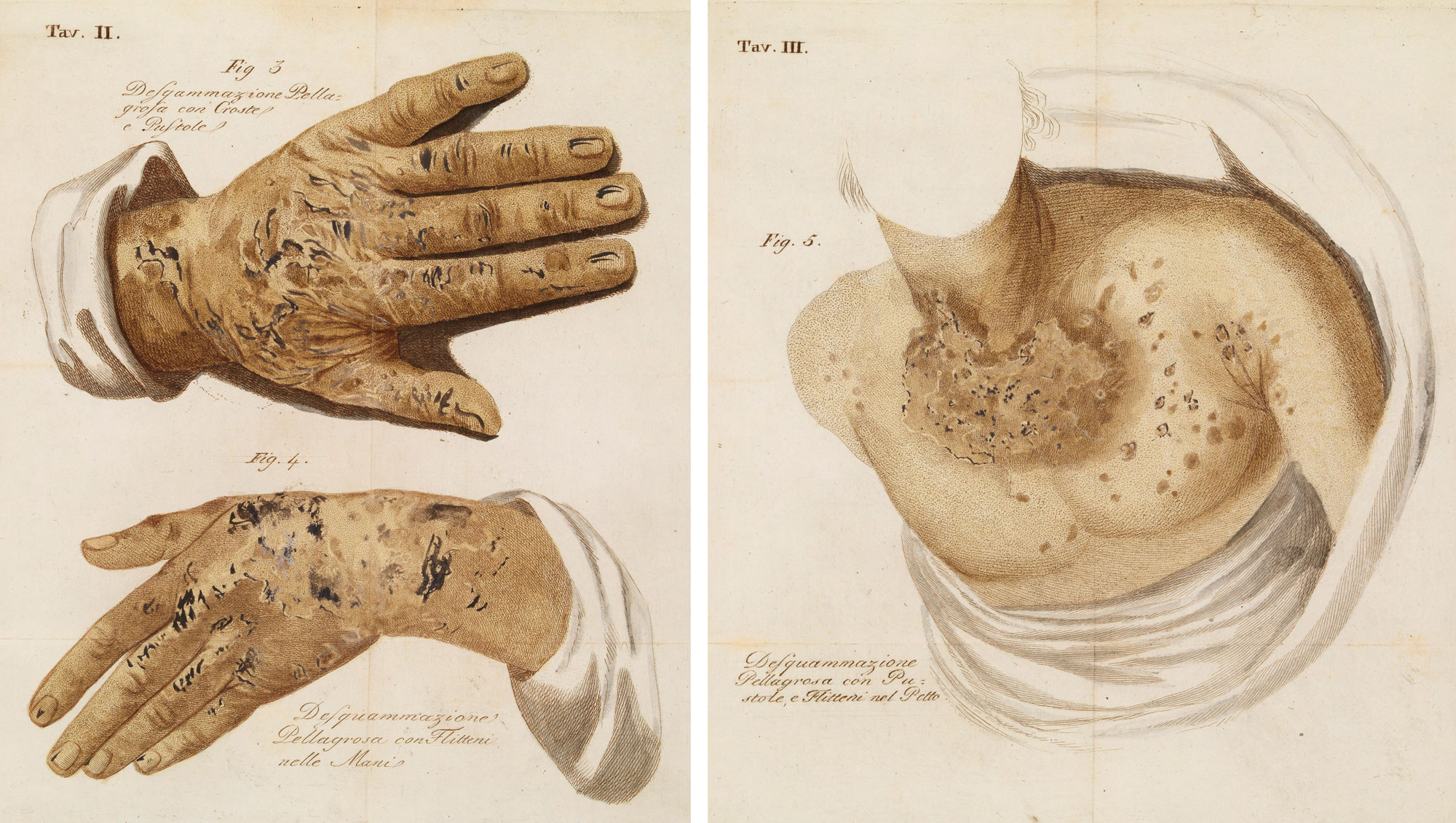
Illustrations of symptoms of pellagra affecting the skin of the hands, chest, and neck of sufferers. Pellagra causes rashes and plaques to develop on sun-exposed skin. Images from Saggio di ricerche sulla pellagra by Di Vincenzio Chiarugi, 1814 (Wellcome Collection, public domain).
Notably, the traditional method of processing maize in Mesoamerica, nixtamalization, in which maize grain is steeped in limewater (water mixed with a small amount of calcium hydroxide), frees niacin in the grain so that it can be absorbed by the body. Nixtamalization thus may have helped prevent the development of pellagra in Mesoamerican peoples who traditionally relied on maize in their diets. (However, some have noted that Mesoamerican peoples also traditionally got niacin from other types of food in their diets.)
Pellagra was once common in parts of Africa, Asia, and Europe and in the southeastern United States, although awareness of the cause of the disease and efforts to add nutrients to some maize products (discussed further below) has made pellagra much less common.

In nixtamalization, maize grains are steeped in water with a small amount of lime. The process removes the pericarp (bran) of the maize, improves its nutritional value, and prolongs its shelf life. Photo by E. Orchardson/CIMMYT (International Maize and Wheat Improvement Center on flickr, Creative Commons Attribution-NonCommercial-ShareAlike 2.0 Generic license, image cropped and resized).
Refined cereals and nutrition
Today, cereals are often refined, meaning that the bran and the germ are removed from the grain during processing. The practice of refining grains became widespread beginning in the 1800s to early 1900s with industrialization, which made refining possible on a large scale.
Refining has some benefits. Removing the germ from grain greatly lengthens the amount of time that it can be stored without spoiling. Many people also prefer the taste and appearance of refined grain products like white rice (polished rice) and all-purpose white flour (made from wheat) over their whole grain counterparts. Even many maize-based food products like corn starch, grits (regular, quick, and instant), some types of corn meal, and corn flour use degerminated maize, or maize with the bran and germ removed.

A bowl of white all-purpose flour, a type of flour made from refined wheat. Photo by Veganbaking.net (flickr, Creative Commons Attribution-ShareAlike 2.0 Generic license).
Unfortunately, refining removes nutrients. For example, white rice is low in thiamine (vitamin B1) because the bran is removed when the rice is polished. Due to the lack of thiamine, consumption of white rice caused many people with largely white-rice-based diets to develop beriberi in the 1700s to early 1900s, but especially after machine polishing of rice became common in the late 1800s. Beriberi can affect the cardiovascular system, muscles, and nerves, and can eventually cause death.

Effects of beriberi. Left: Swollen leg of a person with wet beriberi; this type of swelling (edema) is caused by cardiovascular problems. Right: A man experiencing leg paralysis due to dry beriberi. Left photo and right photo from the Tropenmuseum, part of the National Museum of World Cultures (Creative Commons Attribution-ShareAlike Unported license, images cropped).
Fortified (enriched) cereals
Due both to the loss of nutrients in processing and to the natural absence of certain nutrients in some cereals, many countries mandate that certain milled (ground or polished) grain products be fortified, or have vitamins and minerals added to them. Nearly 70 countries mandate that wheat flour be fortified, whereas fewer than 20 countries mandate that maize flour be fortified, and fewer than 10 require that rice be fortified.
Maize flour, wheat flour, and polished rice produced in the United States must be fortified with iron and some vitamins. In the U.S.A., fortified products are often labeled enriched. The added nutrients are included in the listed ingredients on the packaging.

A nutrition label from a package of yellow corn meal made from whole-kernel corn, U.S.A. Note that the label indicates that the product is enriched. The added nutrients, including niacin (vitamin B3), iron, thiamin mononitrate (vitamin B1), riboflavin (vitamin B2), and folic acid (folate, vitamin B9), are listed as ingredients near the bottom of the package. Photo by E.J. Hermsen.
Types of cereals
Maize (corn)
Maize (Zea mays), sometimes called corn (although the term "corn" is used synonymously with "grain" in some parts of the world), is the only major cereal crop from the Americas. It was domesticated in Mexico from teosinte, probably more than 9000 years ago. The oldest maize ears known from the archaeological record are more than 6000 years old.
Today, maize is the most important cereal commodity crop in the world, and the world's second most important commodity crop after sugarcane. The grain is used for animal feed and human consumption, as well as to produce corn syrup, cornstarch, ethanol biofuel, and other products. Some maize is used to produce bourbon, a type of whisky that must be made using at least 51% maize grain. The United States, China, and Brazil are the world's top three producers of maize, growing more than 60% of the world's crop.
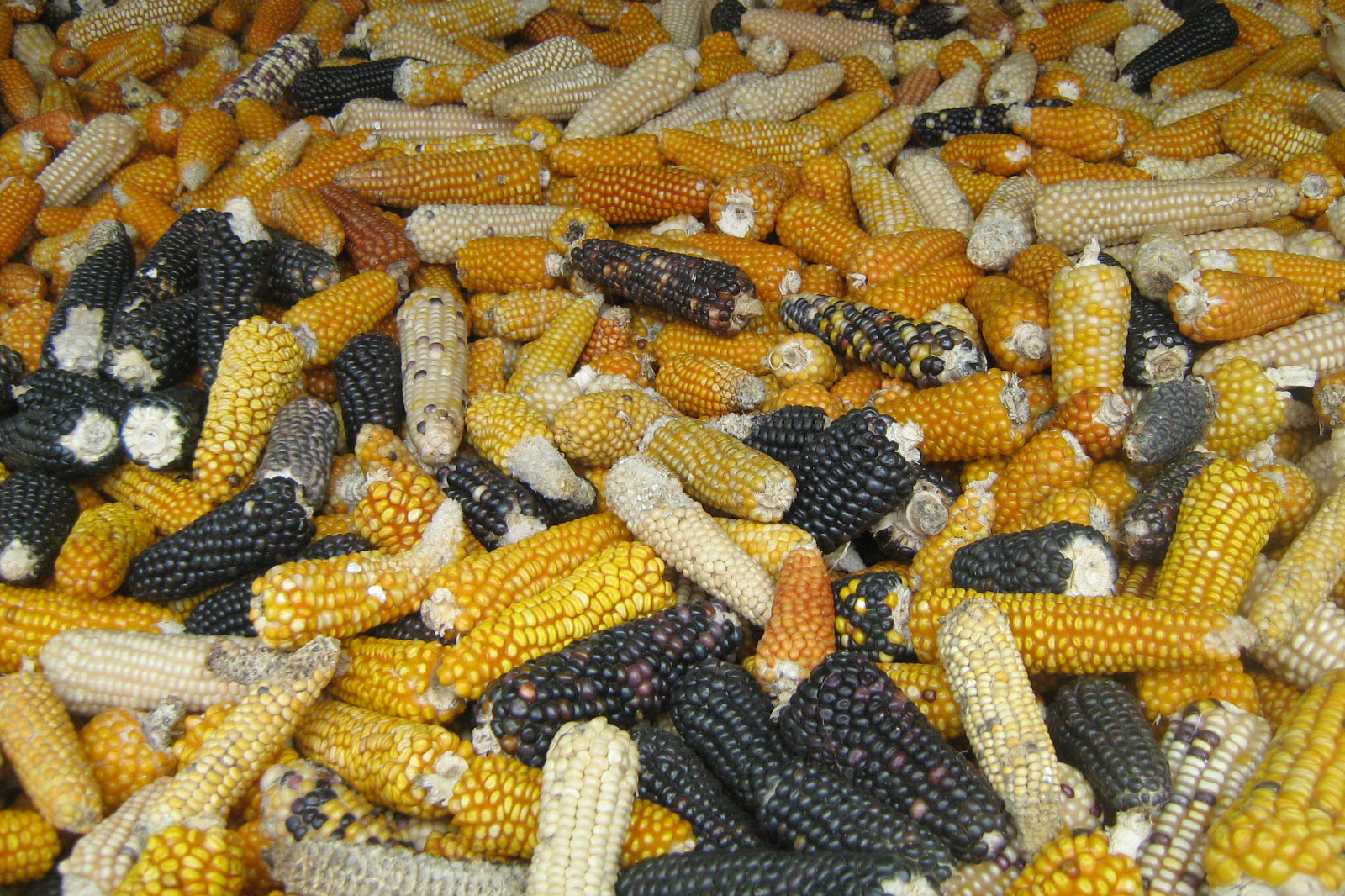
Ears of maize (Zea mays) in Guatemala. Photo by María Victoria López Alfaro (Wikimedia Commons, Creative Commons Attribution-ShareAlike 3.0 Unported license, image cropped).
Wheat, barley, rye, and triticale
Wheat, barley, rye, and triticale are all members of the Wheatgrass Tribe (Triticeae), one of the tribes of cool-season grasses (subfamily Pooideae). These cereals were domesticated in the ancient Fertile Crescent and surrounding region, essentially the region today known as the Middle East. Barley and wheat were among the first crops to be domesticated, as long as 10,000 to 10,500 years ago. The grains from the domesticated grasses in this tribe contain gluten.
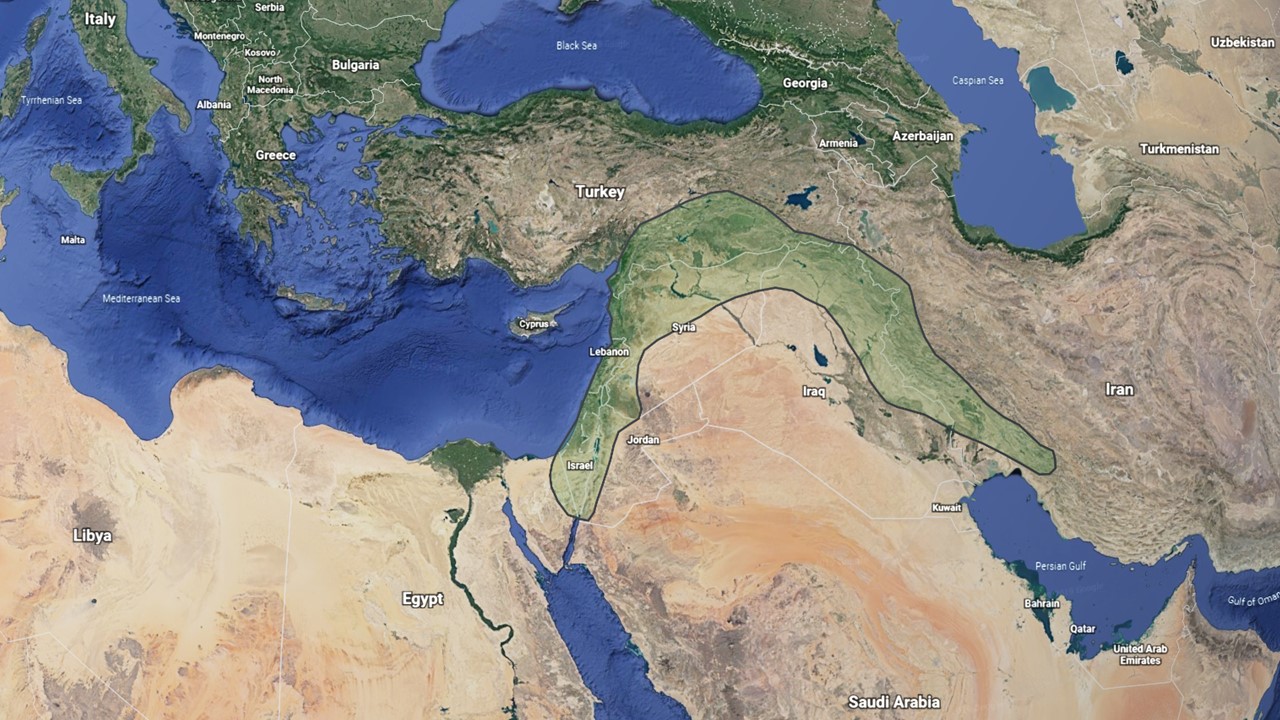
Map showing the Fertile Crescent. From: Volk, G. M., and P. F. Byrne. Crop wild relatives and their use in plant breeding. Colorado State University, eBook.
Wheat includes more than one species in the genus Triticum. The earliest domesticated wheats were einkorn wheat (T. monococcum) and emmer wheat (T. dicoccum), whereas the most widely grown wheats today are bread wheat (T. aestivum) and durum wheat (T. durum), which is used to make pasta. China, the European Union, India, and Russia together produce more than half of the world's wheat. Wheat is ranked as the second or third most important cereal commodity in the world.
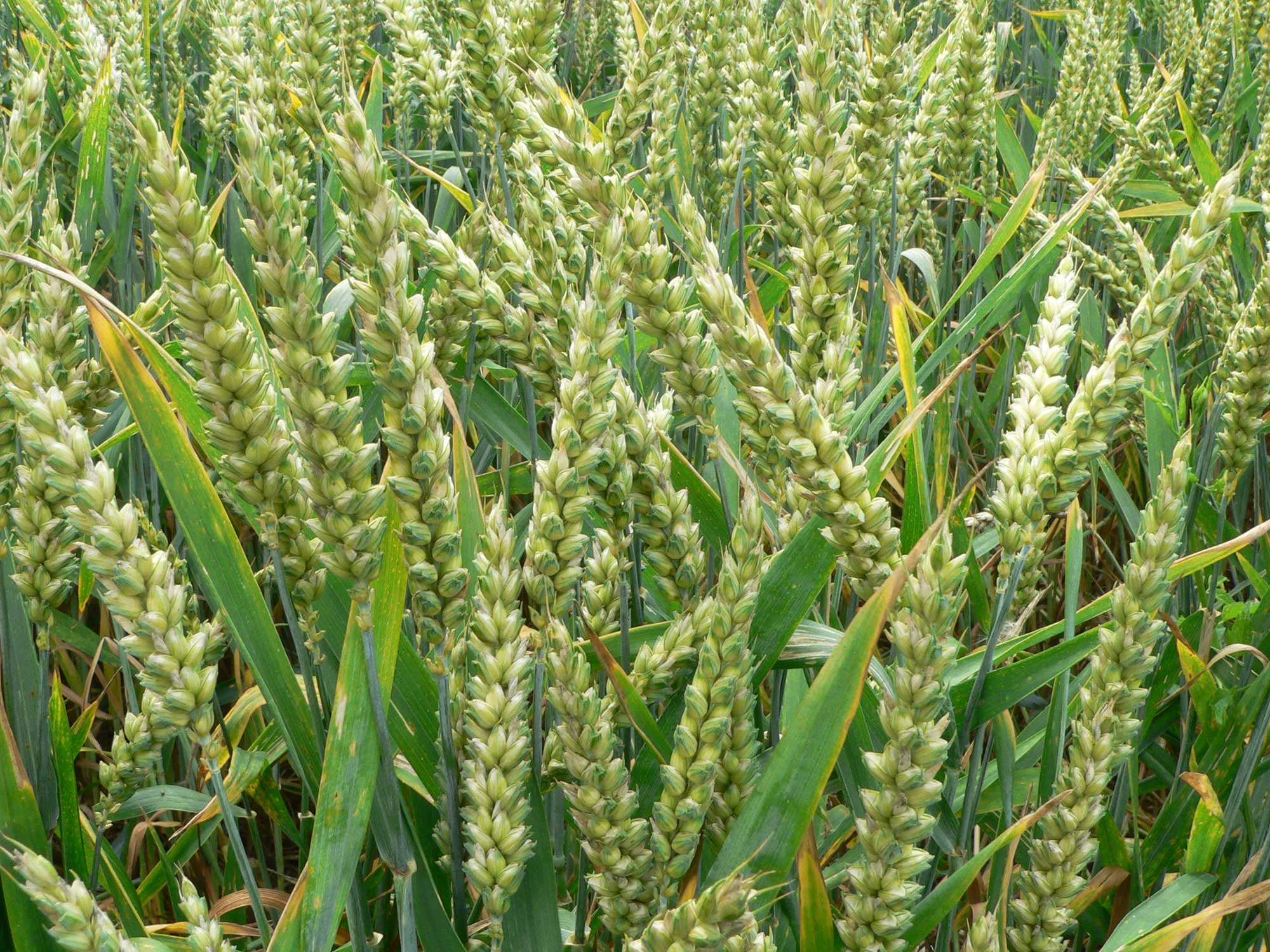
Bread wheat (Triticum aestivum) in a field, France. Photo by David Monniaux (Wikimedia Commons, Creative Commons Attribution 3.0 Unported license, image resized).
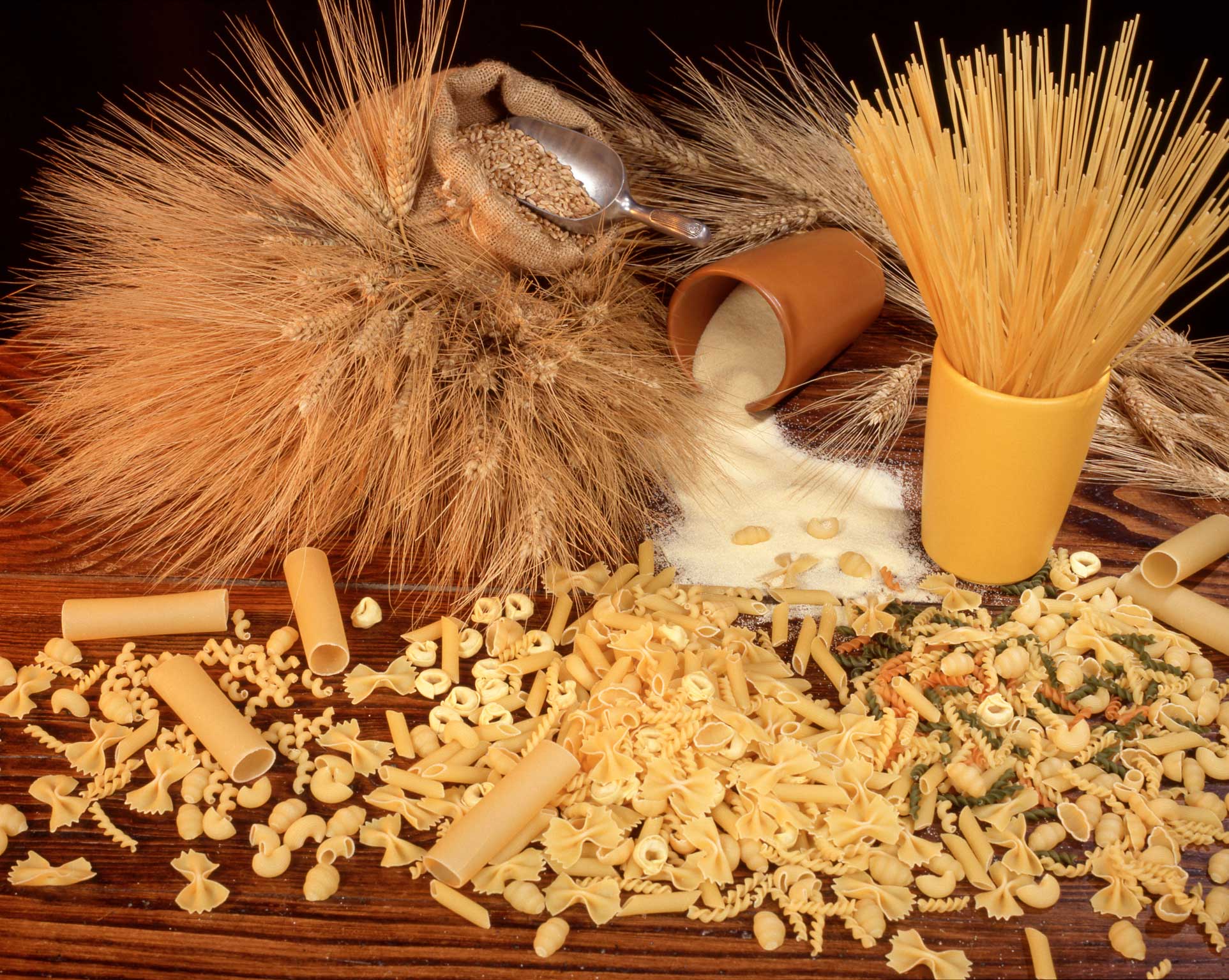
Durum wheat (Triticum turgidum) with pasta products made from durum wheat. Photo by Jean Weber (flickr, Creative Commons Attribution 2.0 Generic license, image resized).
Originally, barley (Hordeum vulgare) was a more important crop than wheat. Barley comes in two-row and six-row forms, with the two-row form the first to appear. Today, barley is the world's fourth most important cereal commodity. The world's top barley producers are the European Union, Russia, and Australia, which account for more than 50% of the world's production. Barley is used for animal feed and human consumption. Barley is also critical in making beer and distilled spirits, which use malted (germinated) barley during the fermentation process.
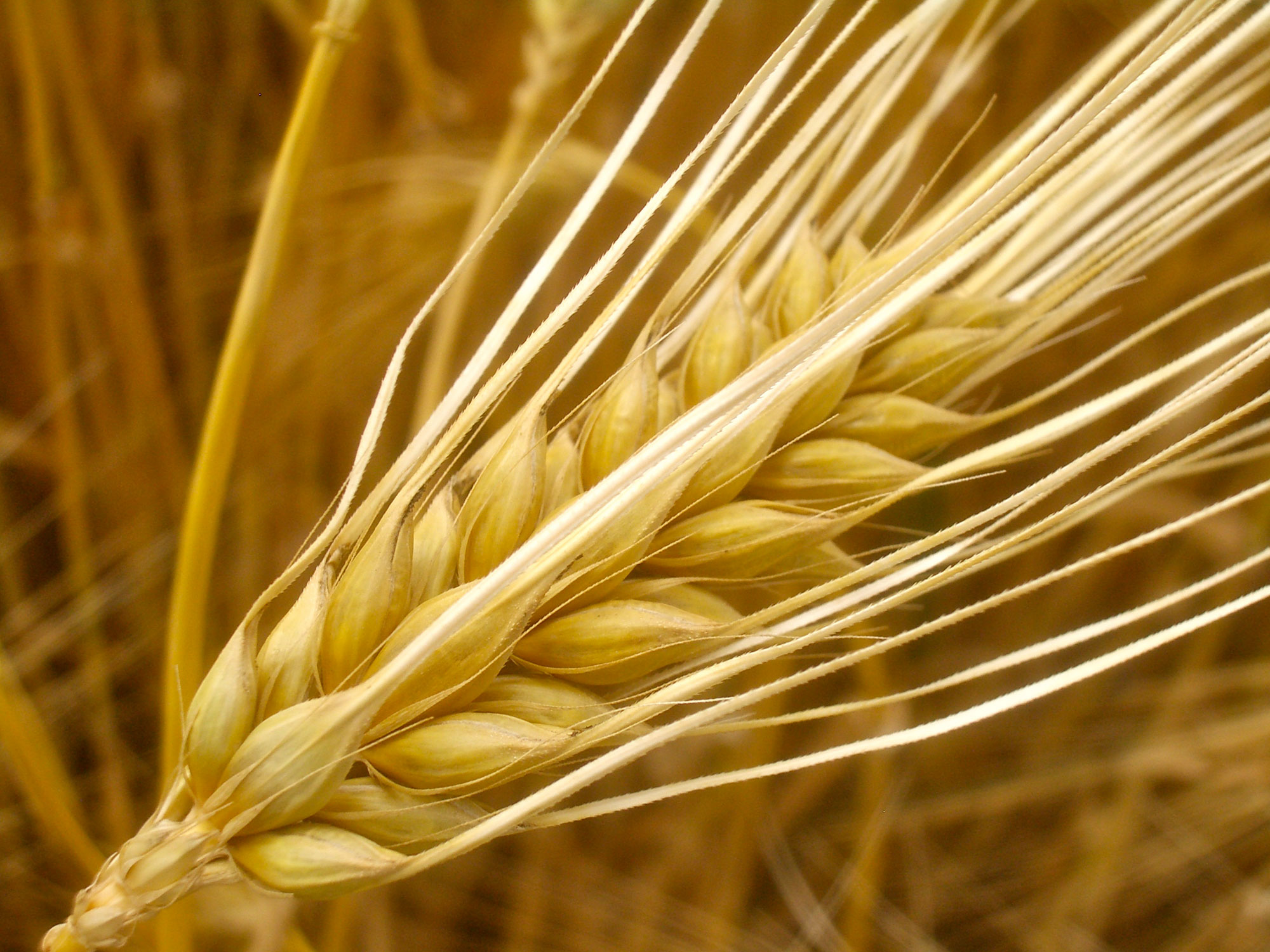
Ear of six-row barley (Hordeum vulgare) showing awned spikelets, Germany. Photo by Alexander von Halem (flickr, Creative Commons Attribution 2.0 Generic license, image resized).
Rye (Secale cereale) may have occurred as a weed in other crops before being eventually domesticated itself. It is well adapted to relatively cold conditions, capable of growing in dry regions and poor soil. It may be mixed with wheat flour to make bread, used to feed livestock, or used to make rye whisky.
Triticale (xTriticosecale), a wheat-rye hybrid developed in the twentieth century, is grown in areas considered marginal for some other grains.
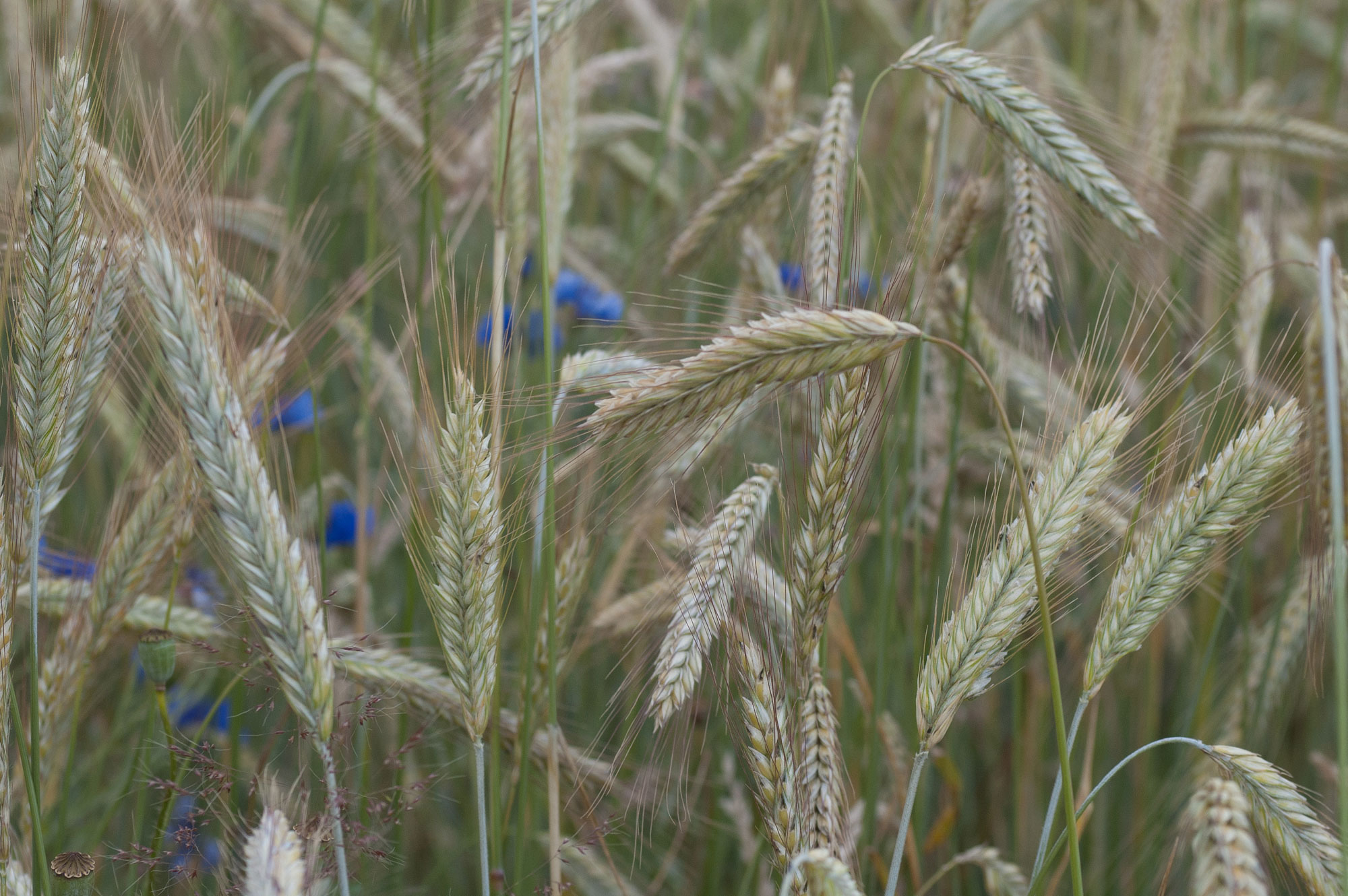
Ears of winter rye (Secale cereale). Photo by Alupus (Wikimedia Commons, Creative Commons Attribution-ShareAlike 3.0 Unported license, image resized).
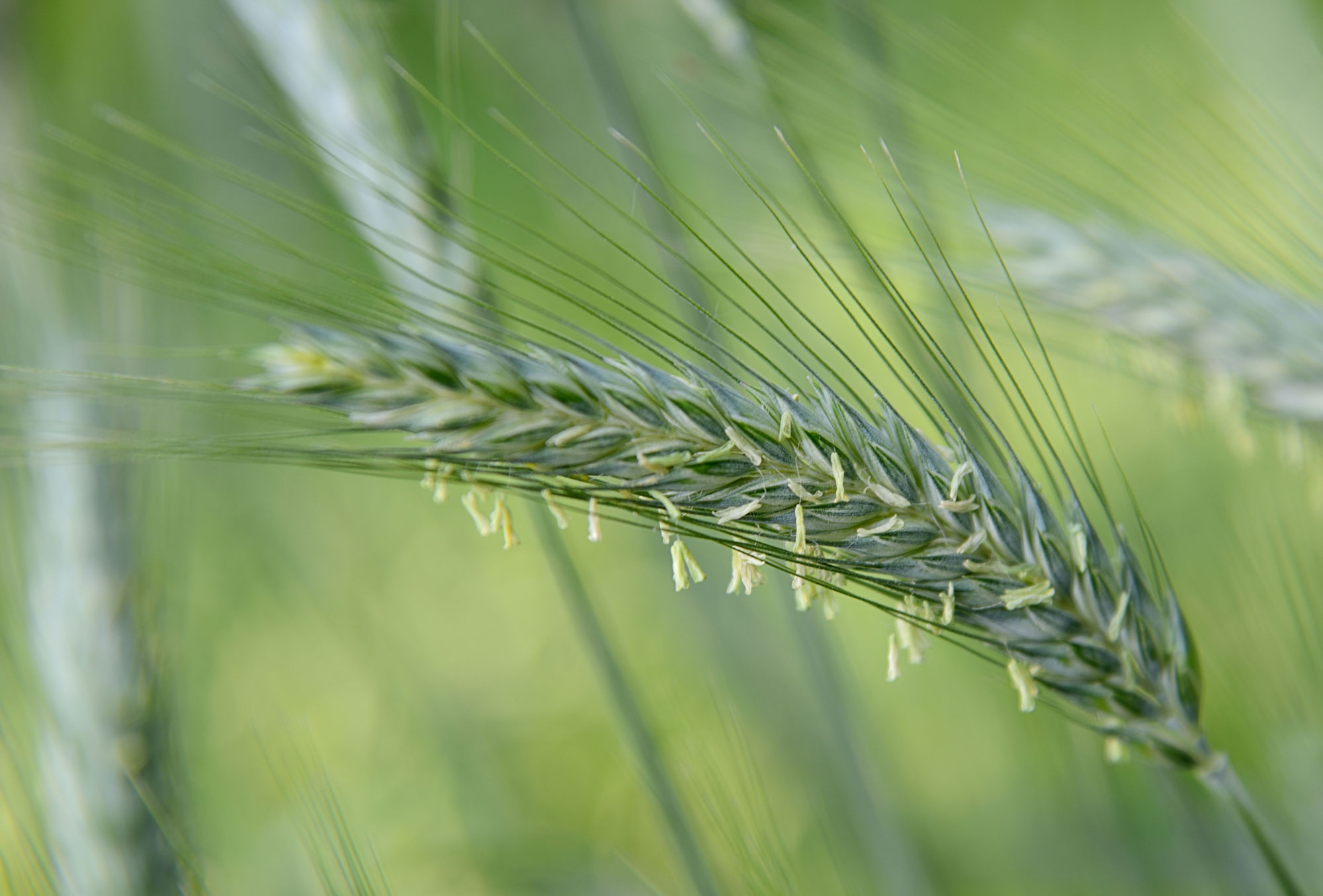
Ears of triticale with stamens hanging out. Photo by Rasbak (Wikimedia Commons, Creative Commons Attribution-ShareAlike 3.0 Unported license, image resized).
Rice
Most cereals commonly called rice are in the Rice Tribe (Tribe Oryzeae in subfamily Oryzoideae). Rice (Oryza sativa), sometimes called Asian rice, is the world's second or third most important cereal commodity. Rice originated in eastern Asia, and was domesticated about 10,000 years ago. It has been an important crop in China for thousands of years, but reached the Middle East much more recently. Today, China and India are the top two producers, growing more than 50% of the world's rice.
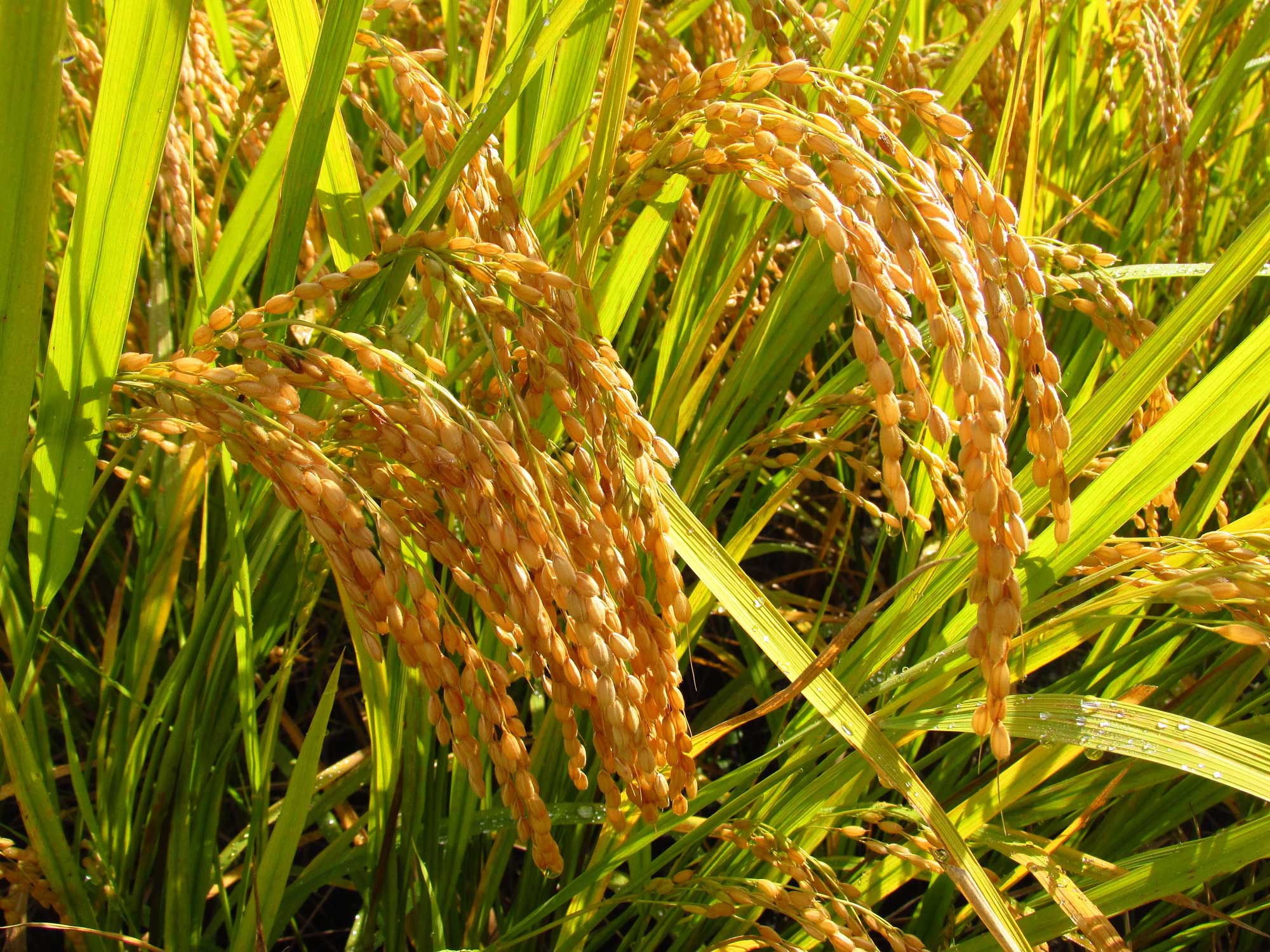
Rice (Oryza sativa), Aomori Prefecture, Japan. Photo by Aomorikuma (Wikimedia Commons, Creative Commons Attribution-ShareAlike 4.0 International license, image resized).
Other rices are known from Africa, North America, and China. African rice (Oryza glaberrima) is a regionally important crop in West Africa, where it was domesticated. Northern wild rice (Zizania palustris), native to North America north of Mexico, is collected from the wild and is in limited cultivation as a specialty crop in the U.S. Manchurian wild rice (Zizania latifolia), native to China, is mostly cultivated as a vegetable rather than a grain crop.
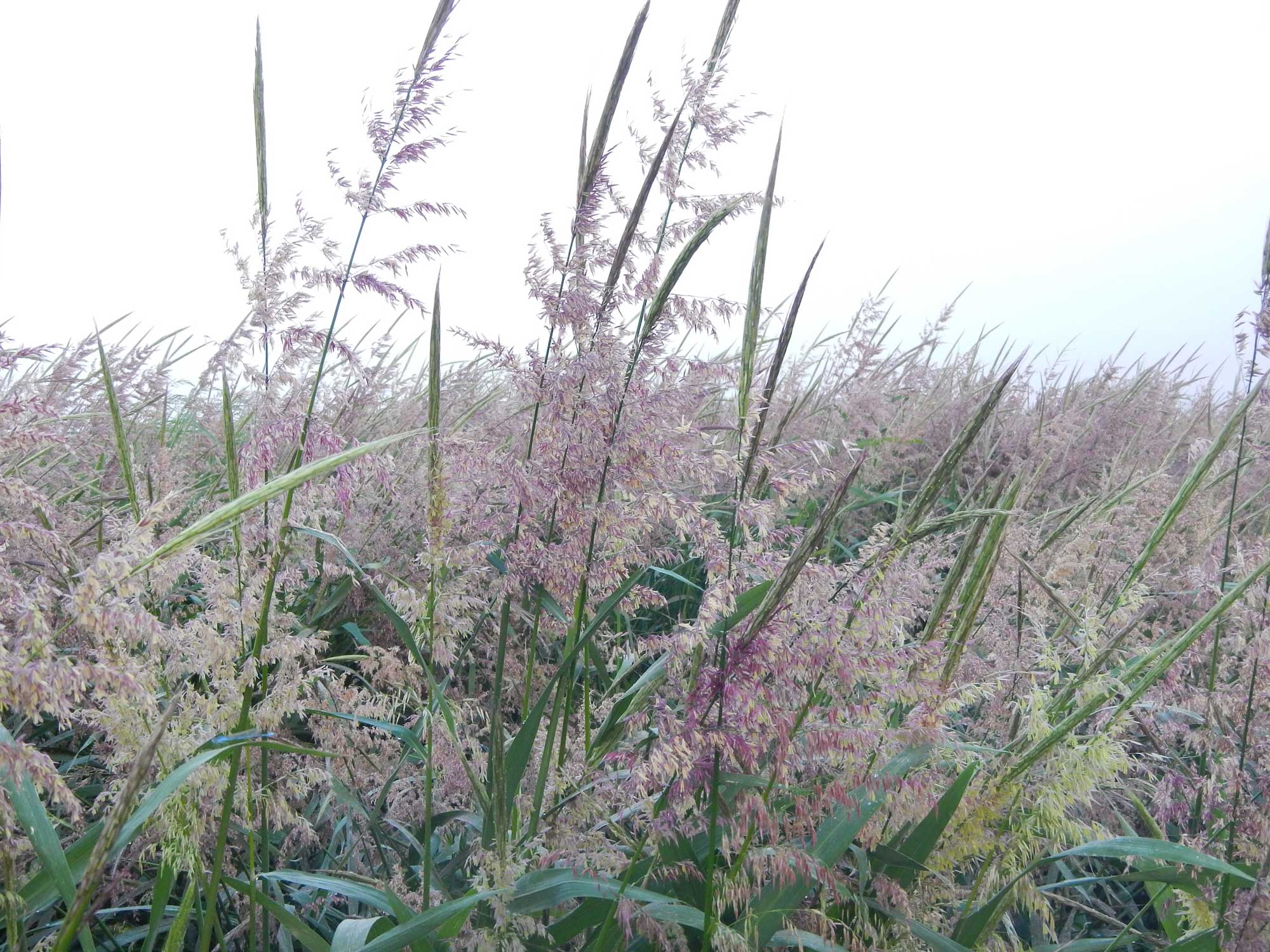
Northern wild rice (Zizania palustris var. interior) cultivated in California, U.S.A. Photo by Matt Lavin (flickr, Creative Commons Attribution-ShareAlike 2.0 Generic license, image resized).
Sorghum
Sorghum (Sorghum bicolor), also called giant millet, milo, jowar, or other names, was domesticated in tropical eastern Africa more than 5000 years ago. Different varieties of sorghum are grown for grain, for the sugar in the plant stems (sweet sorghum), and for their inflorescence branches (broomcorn).
Sorghum is the world's fifth most important cereal; it is a major cereal grain for human consumption in the dry tropics worldwide. The grain is also used in beer brewing, particularly in Africa, and the grain and other plant parts are used to feed livestock. The top two producers of sorghum today are Nigeria and the United States, which together account for more than 20% of production.
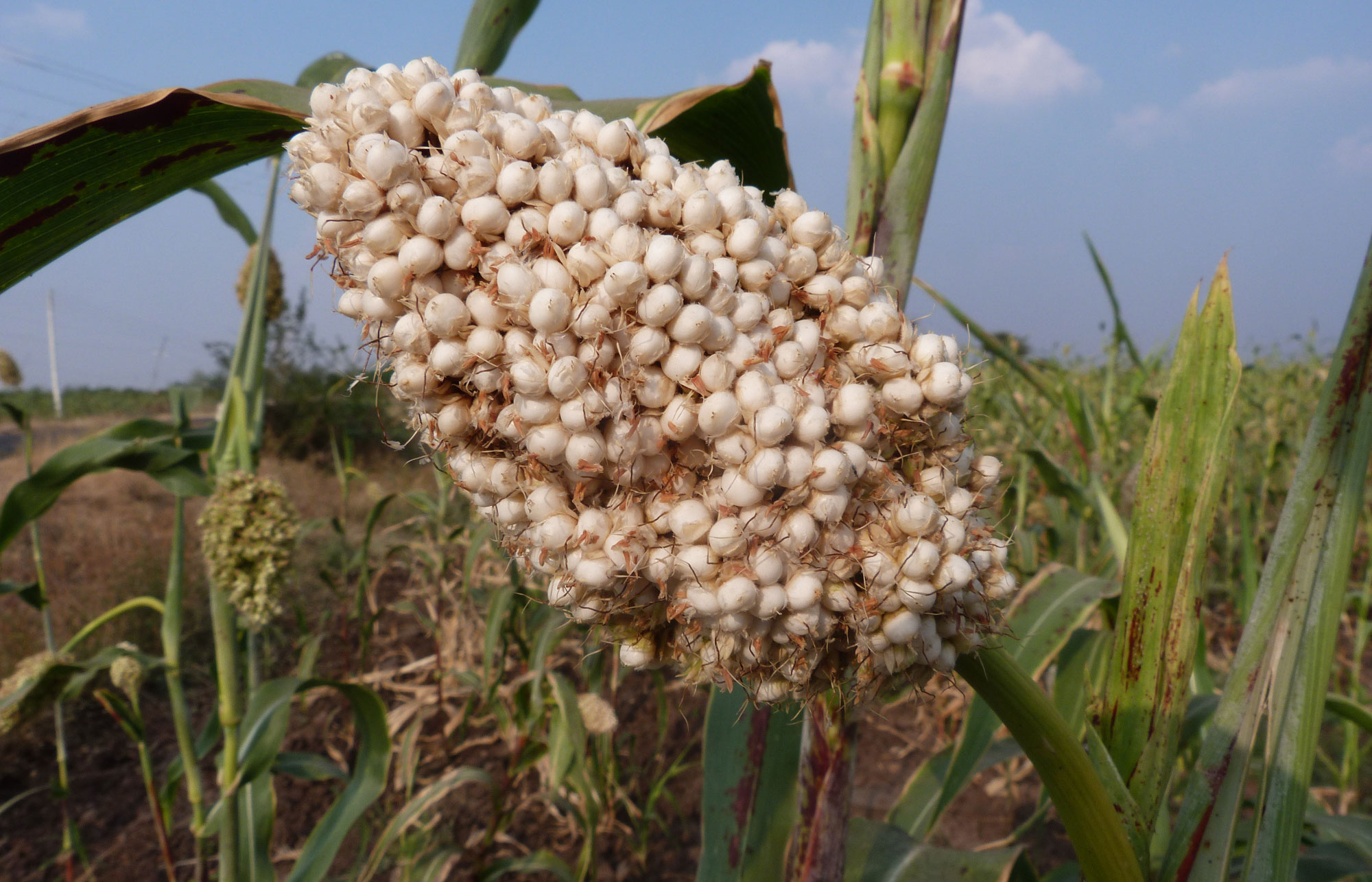
Sorghum or jowar (Sorghum bicolor), Maharashtra, India. Photo by MGB CEE (Wikimedia Commons, Creative Commons Attribution-ShareAlike 4.0 International license, image cropped and resized).
Millet
A variety of small-seeded grasses are classified agriculturally as millet. Most of these grasses are in the Millet Tribe (Tribe Paniceae in subfamily Panicoideae). They were mostly domesticated in Africa and Asia, and they can often be grown in conditions considered marginal for other cereal crops.

Regions of domestication for various millets. Left: Black = finger millet (Eleusine coracana), red = Indian barnyard millet (Echinochloa fruentacea), blue = Proso millet (Panicum millaceum), orange = Japanese barnyard millet (Echinochloa esculenta). Center: Yellow = little millet (Panicum sumatrense), green = foxtail millet (Setaria italica). Right: Purple = kodo millet (Paspalum scrobiculatum). Source: Modified from Goron and Raizada (2014) Frontiers in Plant Science (Creative Commons Attribution 4.0 International license, image reconfigured).
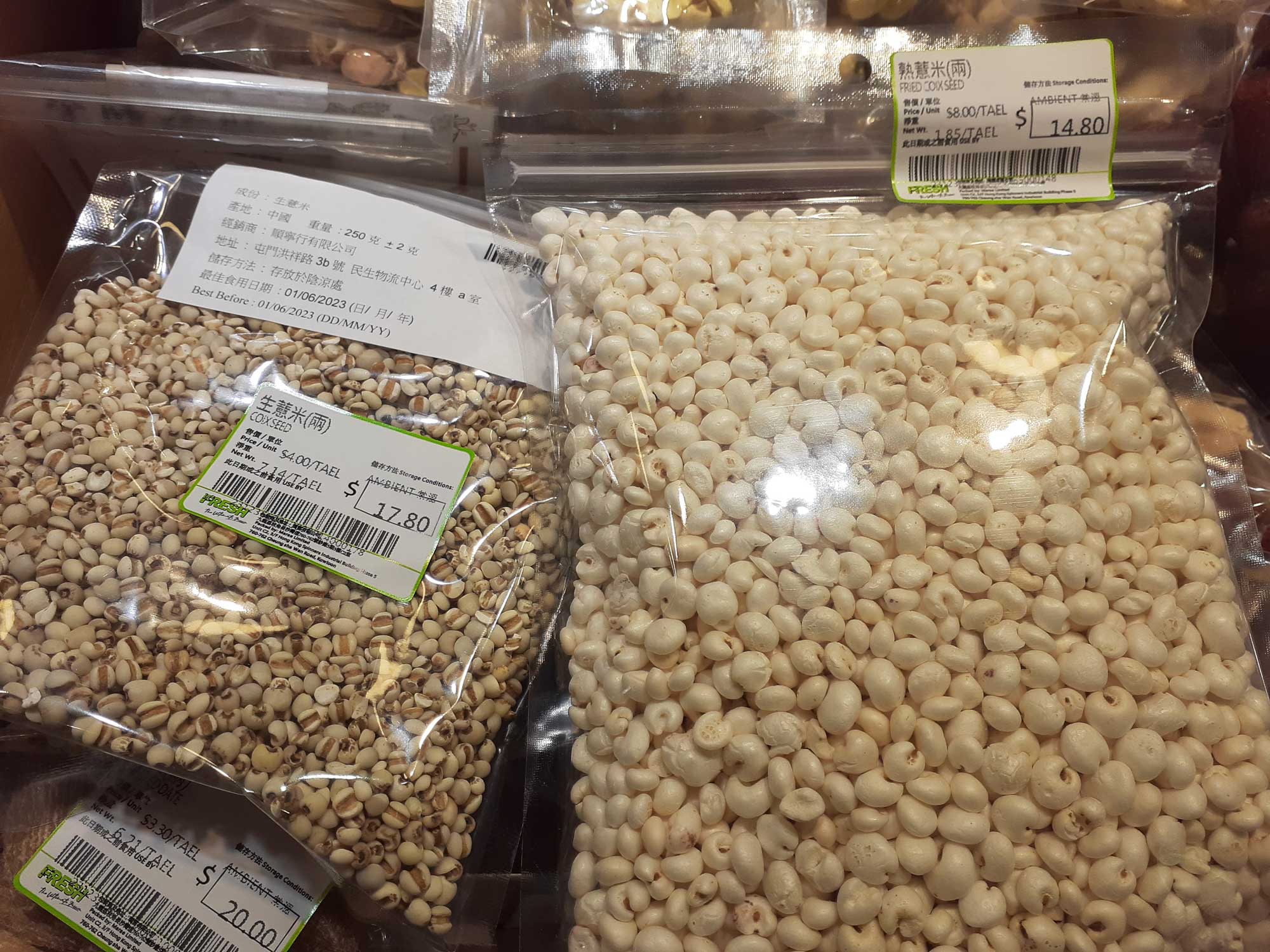
Bags of adlay grains (left) and fried grains (right), here labeled "coix seed," for sale in Hong Kong, 2021. Adlay millet or job's tears is a minor cereal native to Asia and cultivatied in the tropics and subtropics around the world. Photo by Zhiufook Hung Kwanling (Wikimedia Commons, Creative Commons Attribution-ShareAlike 4.0 International license, image resized).
The most widely cultivated millet is pearl millet (Cenchrus americanus). Evidence of domesticated pearl millet is known from about 4500 years ago in West Africa. The world's top producers of millet are India, Niger, and China, which together grow slightly less than 50% of the the world's millet.
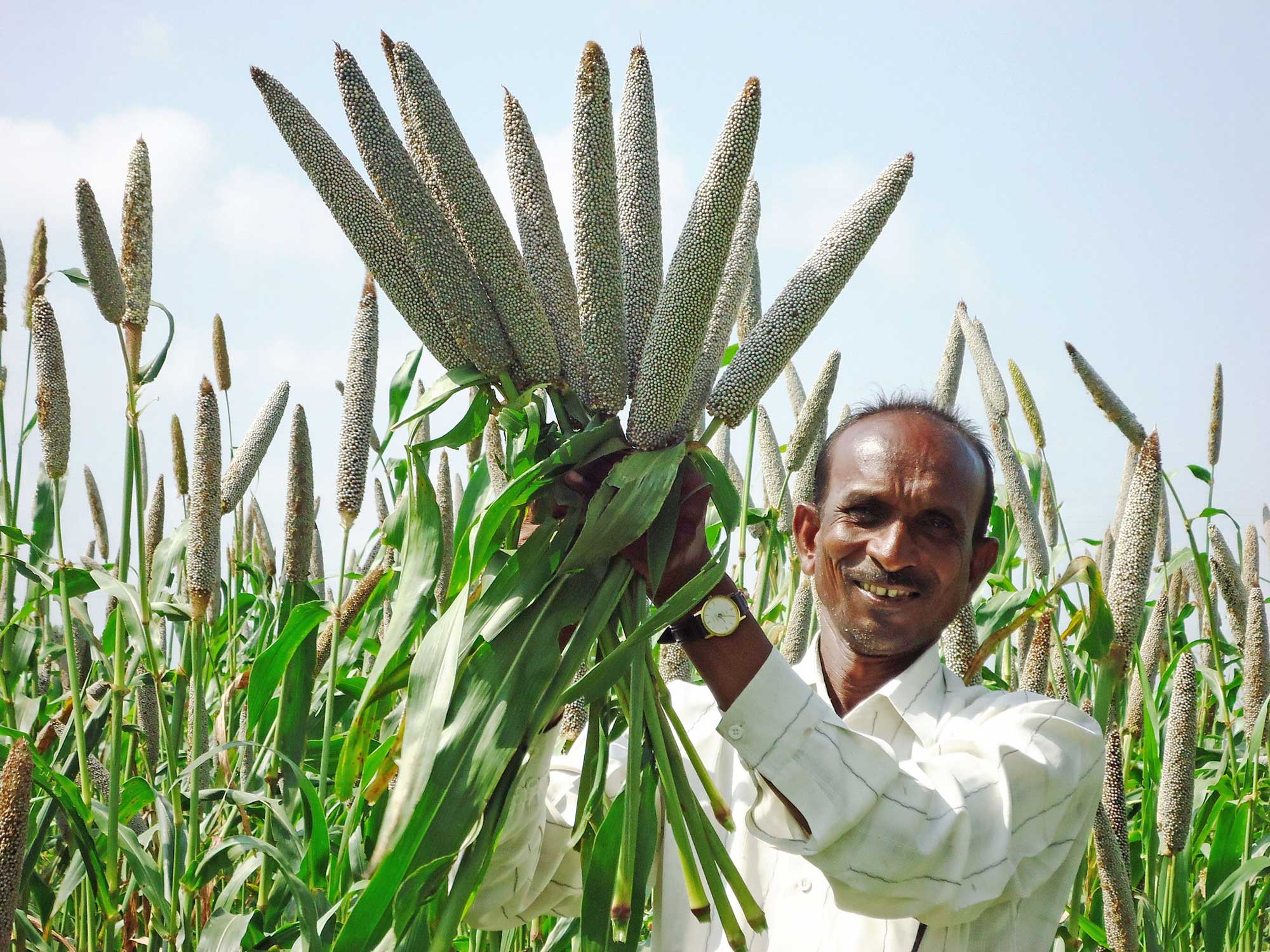
A man holding a bundle of ears from a high-iron variety of pearl millet (Cenchrus americanus), India, 2011. Photo by A.S. Rao, ICRISAT (flickr, Creative Commons Attribution-NonCommercial 2.0 Generic license, image resized).
Oats
Oats (Avena sativa) originated in the Mediterranean region and were domesticated by at least 7600 to 7400 years ago. Like domesticated rye, oats probably began the process of domestication as an agricultural weed. Most oats are produced in Russia and Canada today. When grown as a grain crop, oats are primarily used for livestock feed and human consumption. While oats have gained a reputation as a health food, global oat production has fallen significantly since the 1960s.
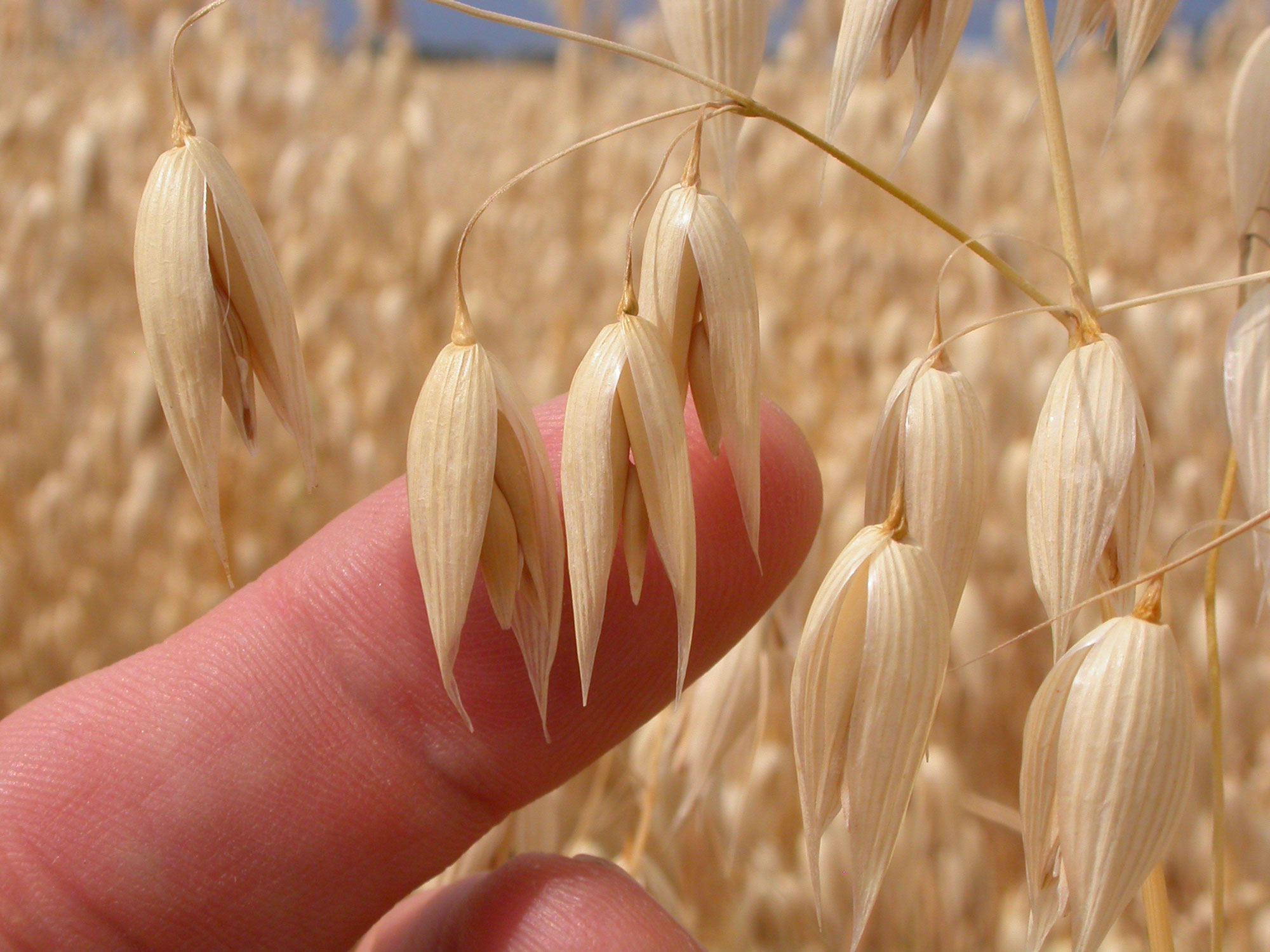
Cultivated oats (Avena sativa), Montana, U.S.A. Photo by Matt Lavin (flickr, Creative Commons Attribution-ShareAlike 2.0 Generic license, image resized).

Global oats production, 1961 to 2020. Map from Our World in Data (Creative Commons Attribution 4.0 International license, image resized).
Processing grain from cereals
Cereals are typically grown as annuals. An annual is a plant that completes its life cycle within a single year (essentially, a single growing season). Thus, cereals produce grains that can be harvested at least once a year, and sometimes more if more than one crop can be planted and harvested in a single growing season.
Following harvest, cereals must be processed in order to separate the edible grains from the inedible (to humans, at least) plant parts. One of the most labor-intensive tasks in traditional agriculture is separating the grains from the straw (stems and leaves) and especially the chaff (surrounding bracts).
In many agricultural systems, machines are used to automate some or all of the tasks of harvesting and processing grain, saving many hours of human labor. The discussion below emphasizes traditional methods carried out without the use modern machines, both to give better insight into the processes involved and also to provide a better basis for understanding some of the modifications that grasses underwent during domestication (discussed in the next section).
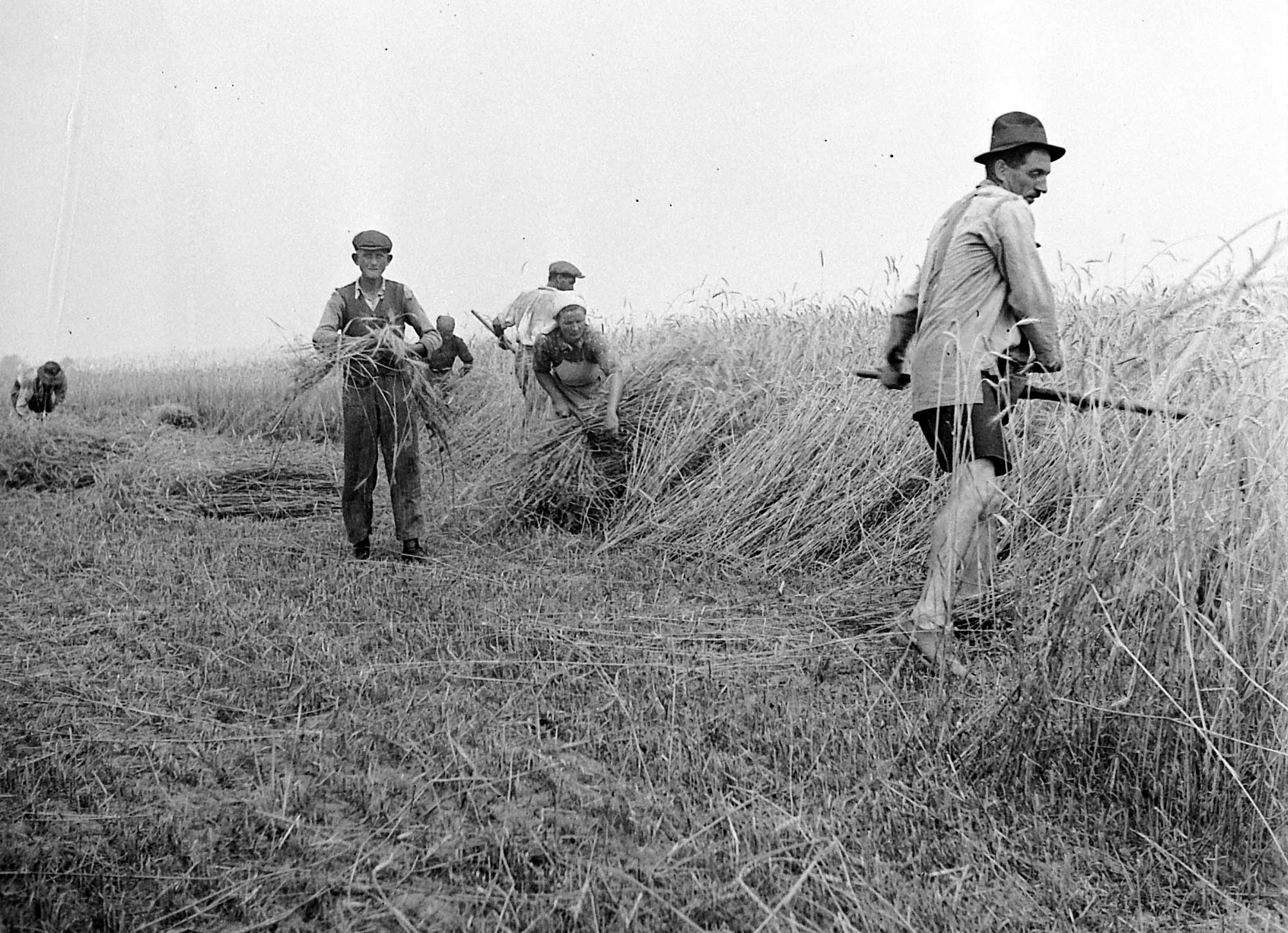
People harvesting grain, Hungary, 1932. Note the men cutting the plants with scythes, tools with curved blades attached to long handles. Photo from Fortepan, ID 2400 (Creative Commons Attribution-ShareAlike 3.0 Unported license, image resized).

Hand harvesting sorghum, Burkina Faso. The man appears to be holding a sickle, or a tool with a short, curved blade. Photo by Rik Schuiling/TropCrop-TCS (Wikimedia Commons, Creative Commons Attribution-ShareAlike 4.0 International license, image resized).
Threshing
The first step in processing many cereals is threshing. When done without machines, threshing might involve beating the plants against wood boards or rocks, beating the plants with sticks or wooden flails, or having people or large animals trample them. Threshing helps to separate the grain from the straw and, in some cases, loosen it from the chaff.
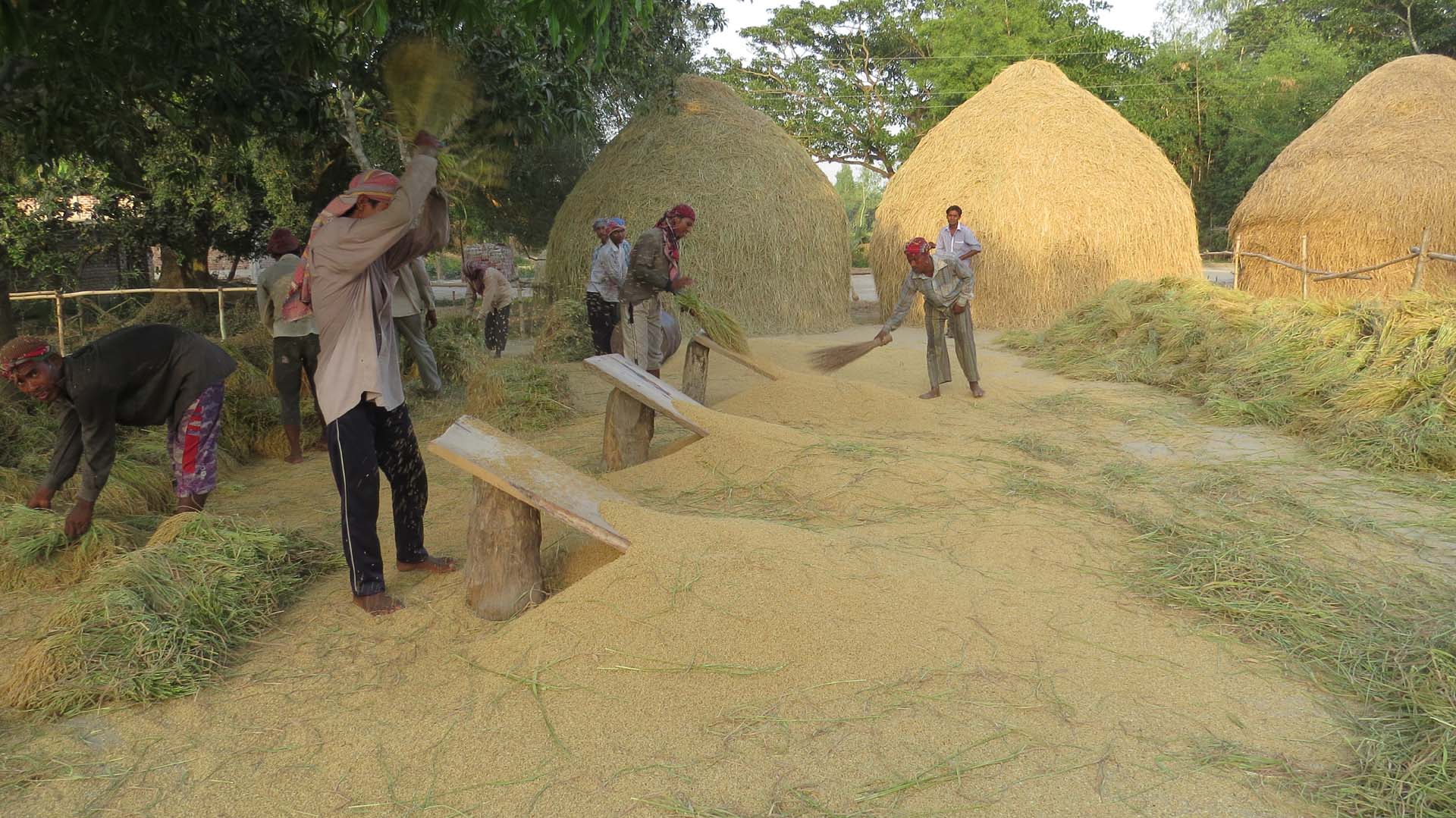
Men threshing rice, Bangladesh. In this type of threshing, bundles of grass are beaten against wooden boards. Photo by Atikur.khokon (Wikimedia Commons, Creative Commons Attribution-ShareAlike 4.0 International license).

Women beating sorghum, Uganda. Photo by Mawejje Geoffrey (Wikimedia Commons, Creative Commons Attribution-ShareAlike 4.0 International license, image resized).
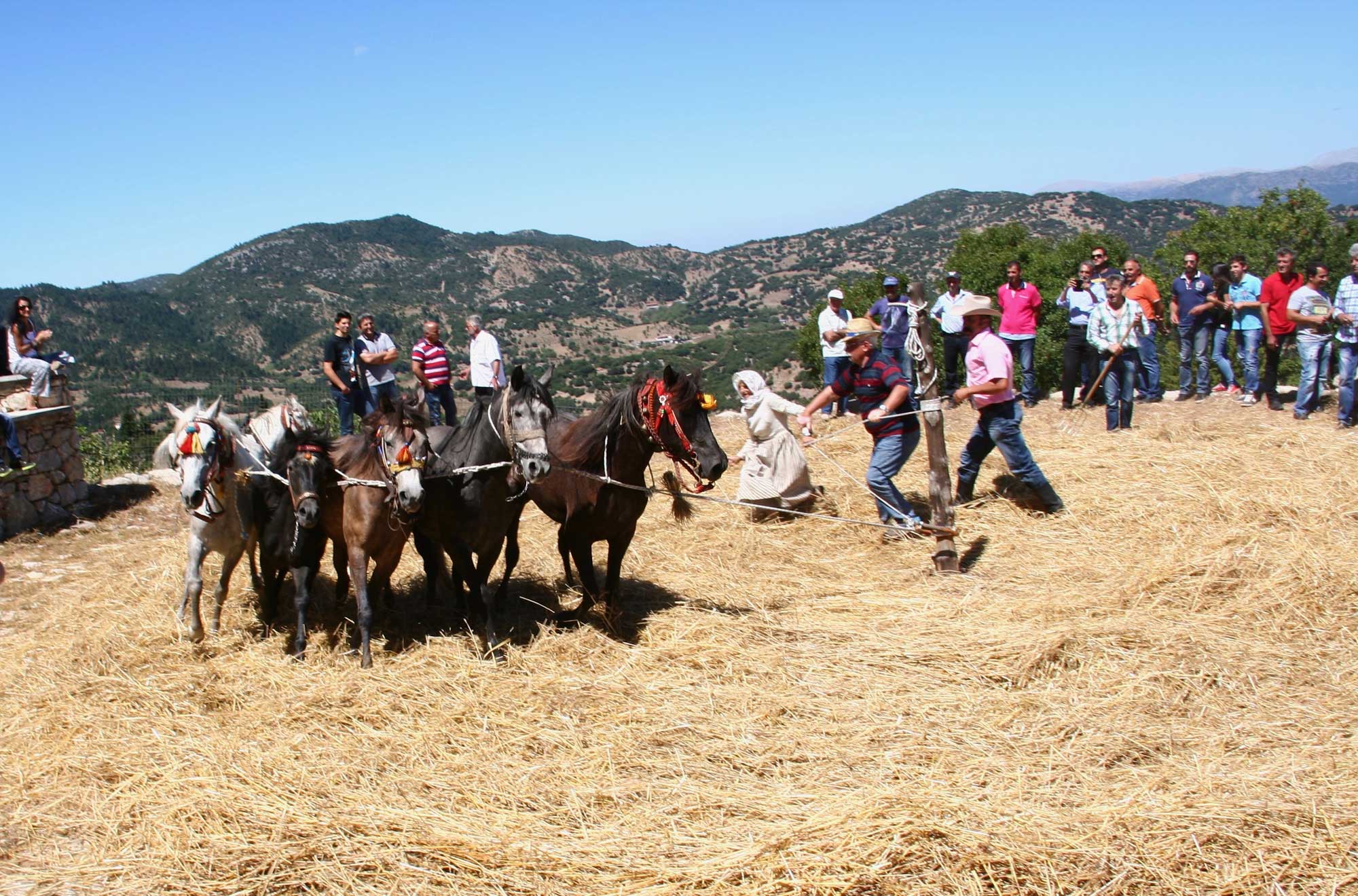
Threshing by trampling, Greece. Photo by RoubinakiM (Wikimedia Commons, Creative Commons Attribution-ShareAlike 4.0 International license, image resized).
Husking (hulling, shucking)
Following threshing, some grains still have a hull, which needs to be removed. The hull is made up of the hard bracts surrounding the grain, like the glumes, lemma, and palea. Traditionally, the hull might have been removed by pounding the grains, for example with a mortar and pestle. Grains with securely attached hulls are called hulled grains, and the process of removing the hull is hulling or husking.
Some domesticated cereals have free-threshing grains. These grains have hulls that are delicate and weakly attached, meaning that the grains are freed relatively easily during threshing and do not require hulling. Barley, wheat, and oats have hulled and free-threshing forms.

Emmer wheat (Triticum dicoccum), a domesticated hulled wheat. Left: Ear with attached spikelets. Center: Spikelets as they would look after threshing, with bracts and rachis segments still attached. Right: Grains as they would appear after hulling. Photo credits: Left photo, center photo, and right photo by Rasbak (Wikimedia Commons, Creative Commons Attribution-ShareAlike 3.0 Unported license, all images cropped and resized).

A wooden device for pounding and hulling rice. The rice is placed in the hole in the ground, and the horizontal wooden bar is moved up and down using the foot, lifting and dropping the peg at the end of the bar into the hole. Akyab Island, Burma (Myanmar), 1945. Photo by Frank Bond (Wikimedia Commons, public domain).
This video shows traditional methods of husking and winnowing rice in India. First, the rice is pounded in a large stone mortar using a wooden pole. Afterward, it is tossed in the air to allow the chaff to blow away, leaving behind the edible rice grains. Video: "Traditional process of husking rice-South India" by WildFilmsIndia, via YouTube.
Maize grains do not have husks surrounding them at all. In order to process maize, the ears of maize are husked (the outer leaves and silk are removed from the ears) and shelled (in shelling, the grain is detached from the cob). Shelling may be done by hand, by placing the ears in a sack and beating them (a method similar to threshing), or with a machine.

Men husking corn, North Carolina, U.S.A. (1939?). Photo by Marion Post Wolcott (Library of Congress Reproduction number LC-DIG-fsa-8a41640, no known restrictions).
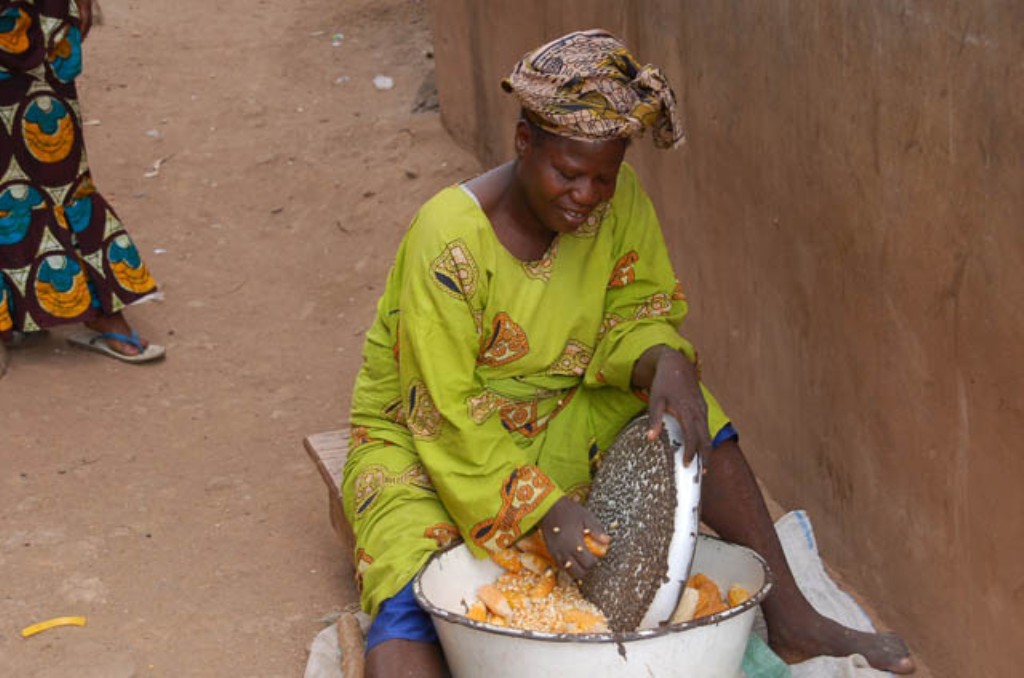
A women using a maize sheller, Nigeria. Photo from International Institute of Tropical Agriculture on flickr (Creative Commons Attribution-NonCommercial 2.0 Generic license).
Winnowing
Once threshed or shelled, grain is typically cleaned prior to storage or further processing. Cleaning by hand is often done by winnowing. In winnowing, grain is tossed into the air or poured out of a container so that the chaff blows away. Methods of doing this might include tossing and catching the grain in a shallow basket, pouring grain between containers, or pouring grain onto a mat or onto the ground. Grain may also be sifted through a screen or sieve.
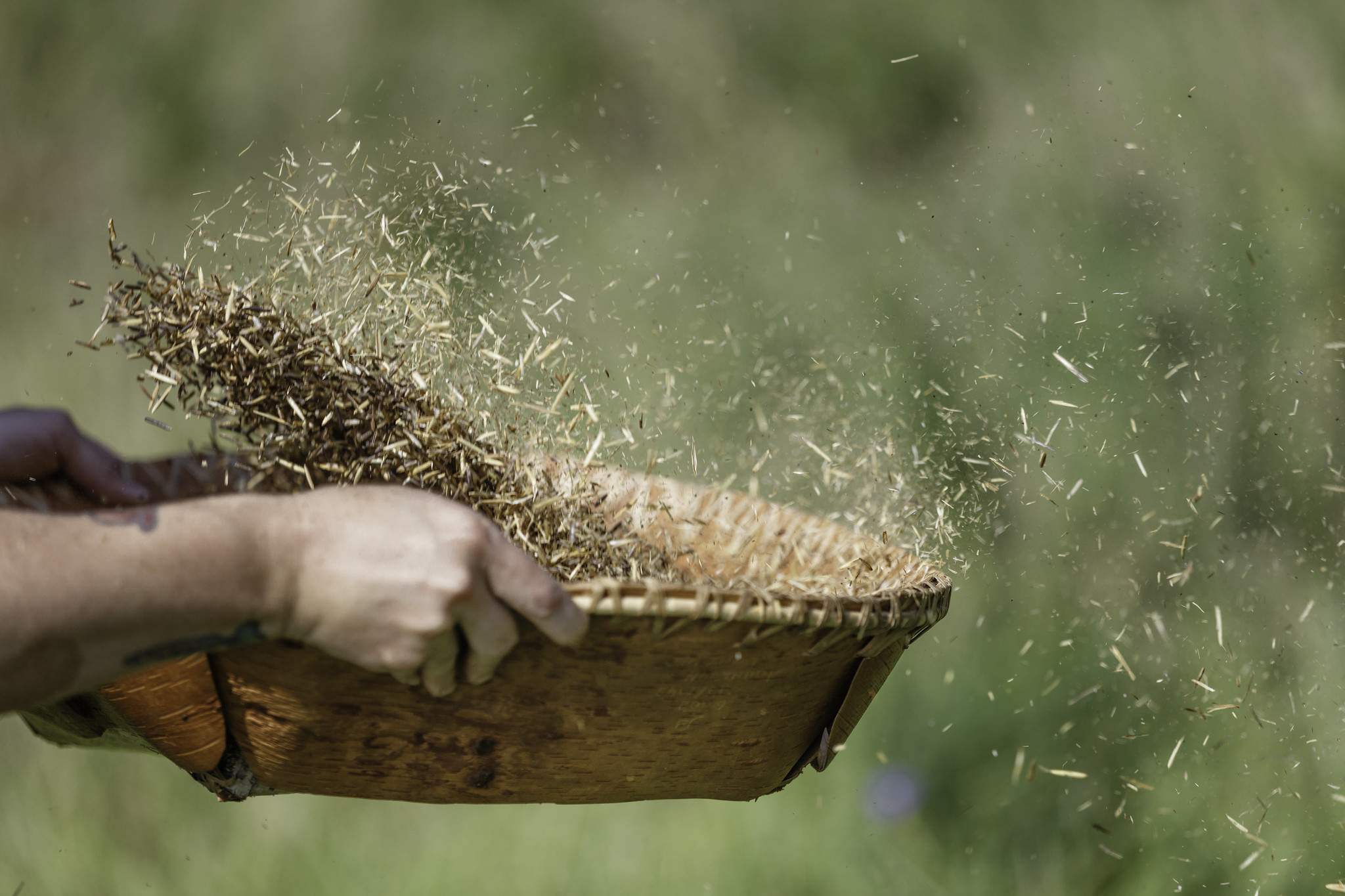
Winnowing wild rice by throwing it into the air and catching it in a basket, Minnesota, U.S.A. Notice the chaff blowing off the rice. Photo by Lorie Shaull (flickr, Creative Commons Attribution 2.0 Generic license).

Women winnowing grain, 1914-1918, Japan. In this image, grain is being poured from a basket onto a mat by one woman, while the second uses a fan to help blow away the chaff. Photo by Elstner Hilton (A.Davey on flickr, Creative Commons Attribution-ShareAlike 2.0 Generic license, image resized).
Grinding
When grain is intended for human consumption, it is often pulverized to make flour or other products. Flour may made using grinding or milling stones or by pounding the grain in a mortar, similar to the process of hulling.
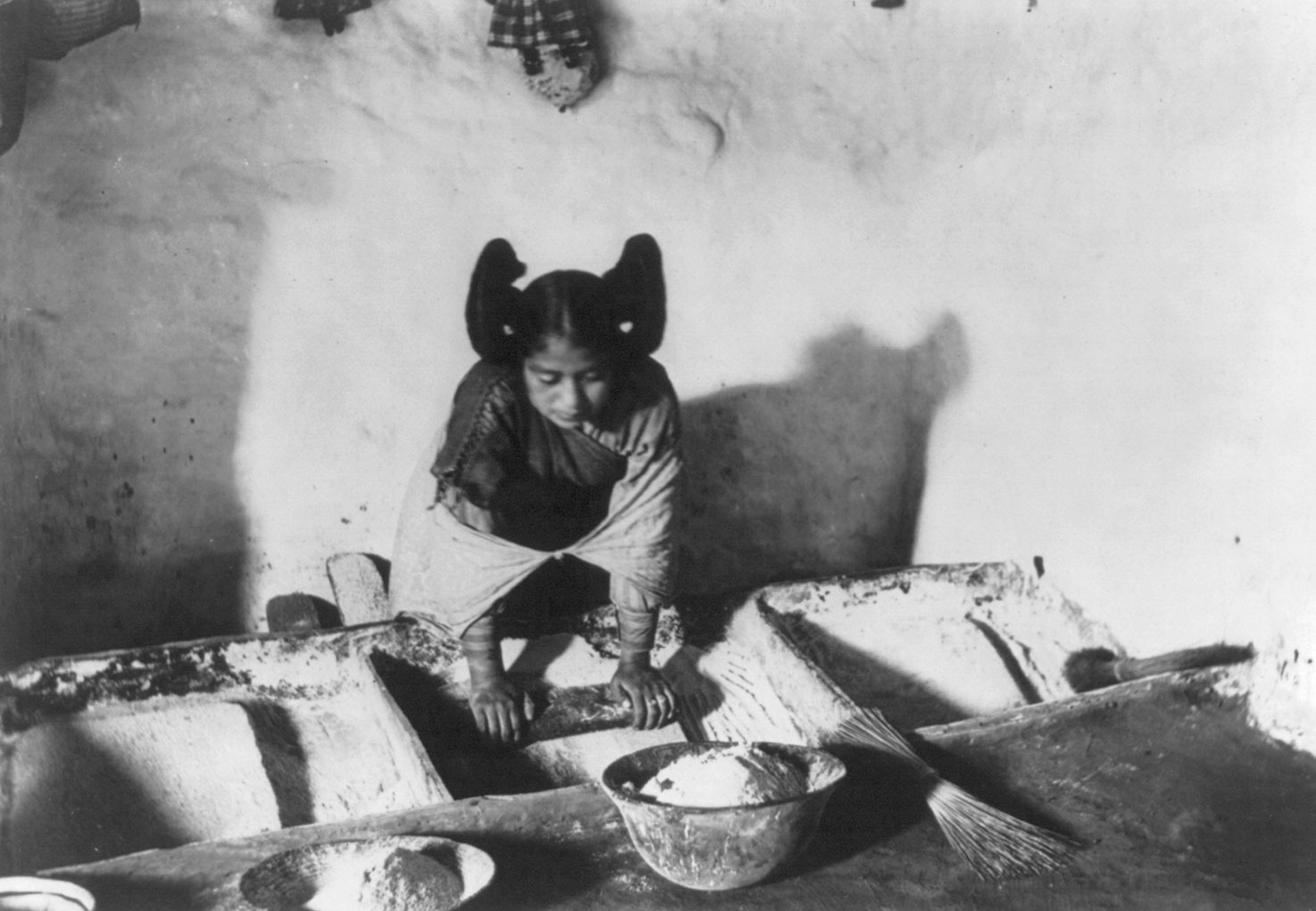
A young Hopi woman grinding corn, Arizona, U.S.A., ca. 1909. Photographer not credited (Library of Congress Reproduction number LC-USZ62-51061, no known restrictions).
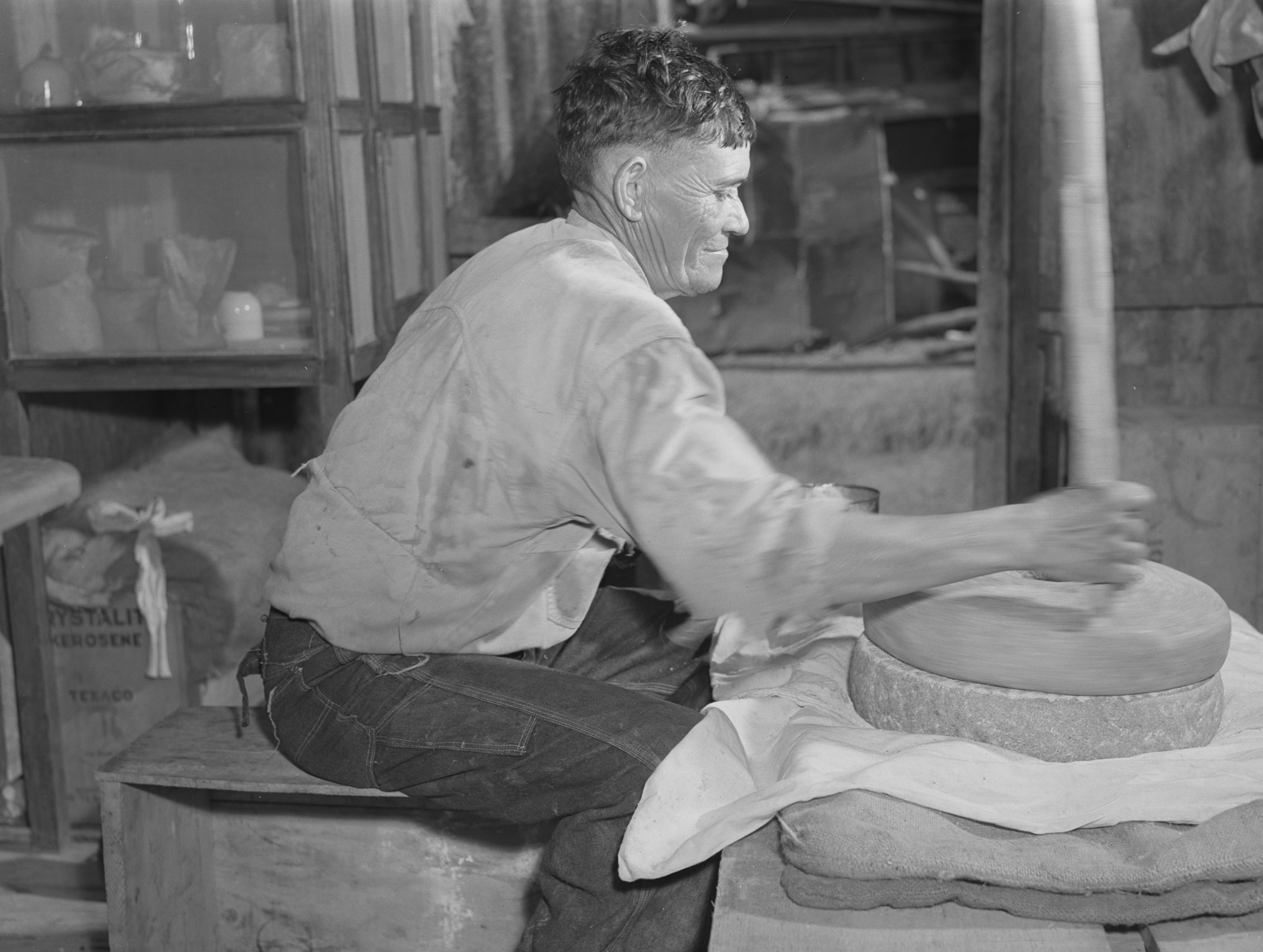
A man grinding maize using a rotary quern, St. Croix Island, 1941. To use these millstones, grain would be poured into a hole in the center of the upper stone. The man in the photo is holding a pole that is fitted into a depression near the edge of the upper stone; he is using the pole to spin the upper stone and grind corn between the upper and lower stones. Photo by Jack Delano (Library of Congress Reproduction number LC-USF34-046941, no known restrictions).
This video shows a person using a rotary quern to grind wheat. Video: "Millstones-Wheat Flour Milling" by Marobud, via YouTube.
Domestication of cereals
Domestication of cereals by humans tended to favor traits that make the plants easier to harvest and the grains easier to process. Below are examples of changes that grasses underwent during the process of transformation into domesticated cereal crops. Note that not all of these changes apply to all cereals.
Stem structure
Domesticated cereals have been selected for stems that are shorter and stronger. Shorter, stronger stems have a few advantage over taller, weaker stems. One is that are shorter plants are less likely to be affected by lodging. Lodging occurs when grasses are permanently bent and become matted down. Lodging may be caused by a number of things, including weather (for example, hail, wind, driving rain) and soil that is too moist or has too many nutrients. When plants become lodged, it is difficult to harvest the grains.
Shorter stems also favor the production of grain over the production of inedible (to humans) leaf and stem tissues. Reduction in stem branching, as seen in domesticated maize, may also have directed energy toward grain production rather than production of stems and leaves.
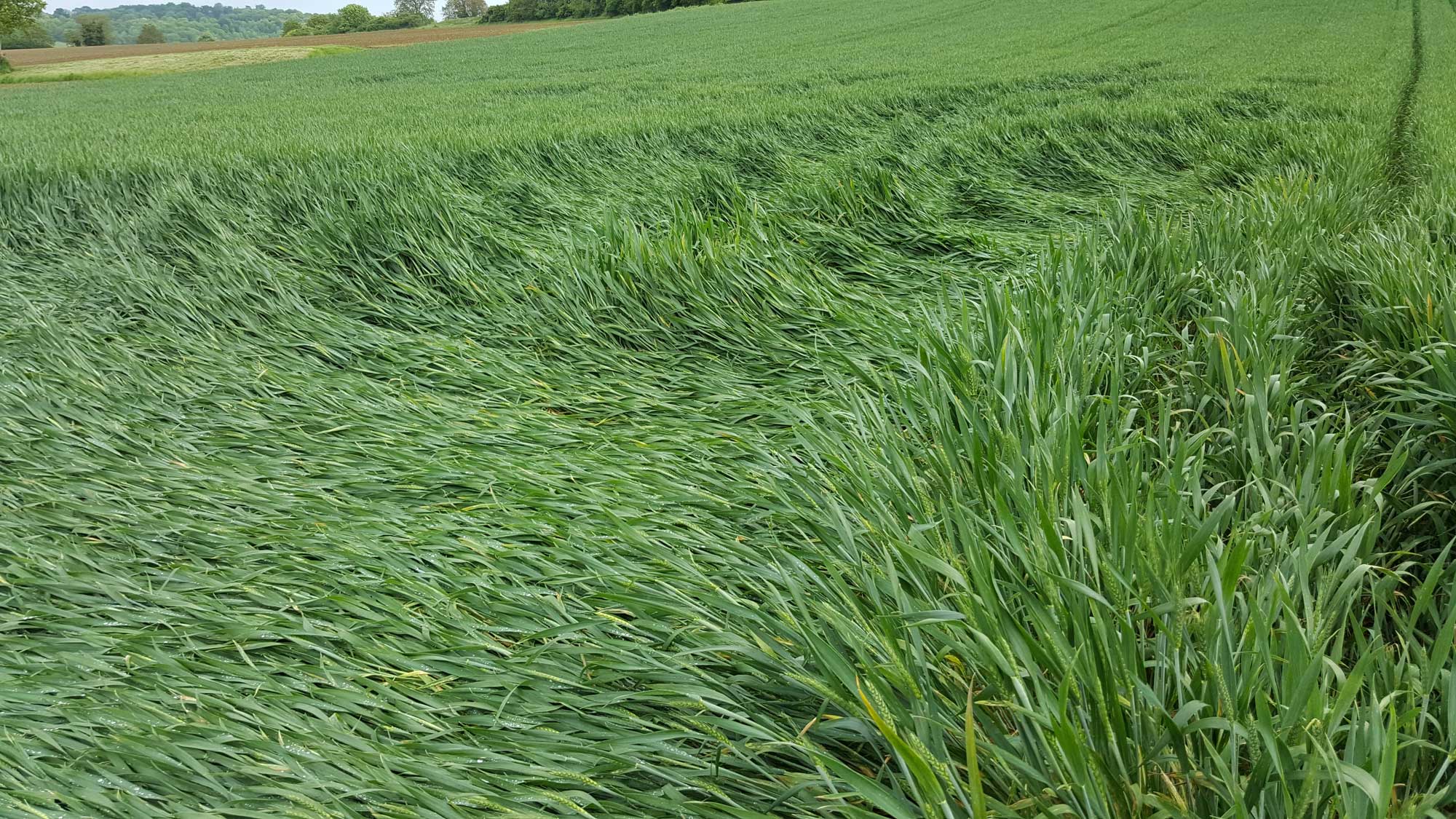
Lodging of wheat after a heavy rainfall, France. Photo by Spedona (Wikimedia Commons, Creative Commons Attribution-ShareAlike 4.0 International license, image resized).
Original caption: "Dr. Patrick Byrne, Colorado State University, highlights examples of contrasting traits in modern wheat and its wild ancestors or heirloom varieties, providing insight into the history of wheat breeding. The featured traits are plant height, harvest index, lodging, and shattering." Video source: "Contrasting wheat traits" via YouTube.
Seed dormancy
Some domesticated cereals have lost the mechanisms that enforce seed dormancy. When a seed is dormant, it cannot germinate, even if conditions like temperature and rainfall are right for growth. Seeds from the same plant may be dormant for different lengths of time so that they germinate in different growing seasons. In wild plants, dormancy helps to prevent seeds from germinating at the wrong time of year, and different lengths of dormancy act as insurance again poor growing seasons or natural disasters that may kill many plants at one time.
In domesticated plants where dormancy mechanisms are removed, seeds can be sown in a field and will grow simultaneously. This allows farmers to control the timing of sowing and crop production. Having a crop that grows and matures at one time also means that it can be harvested at one time, saving labor.
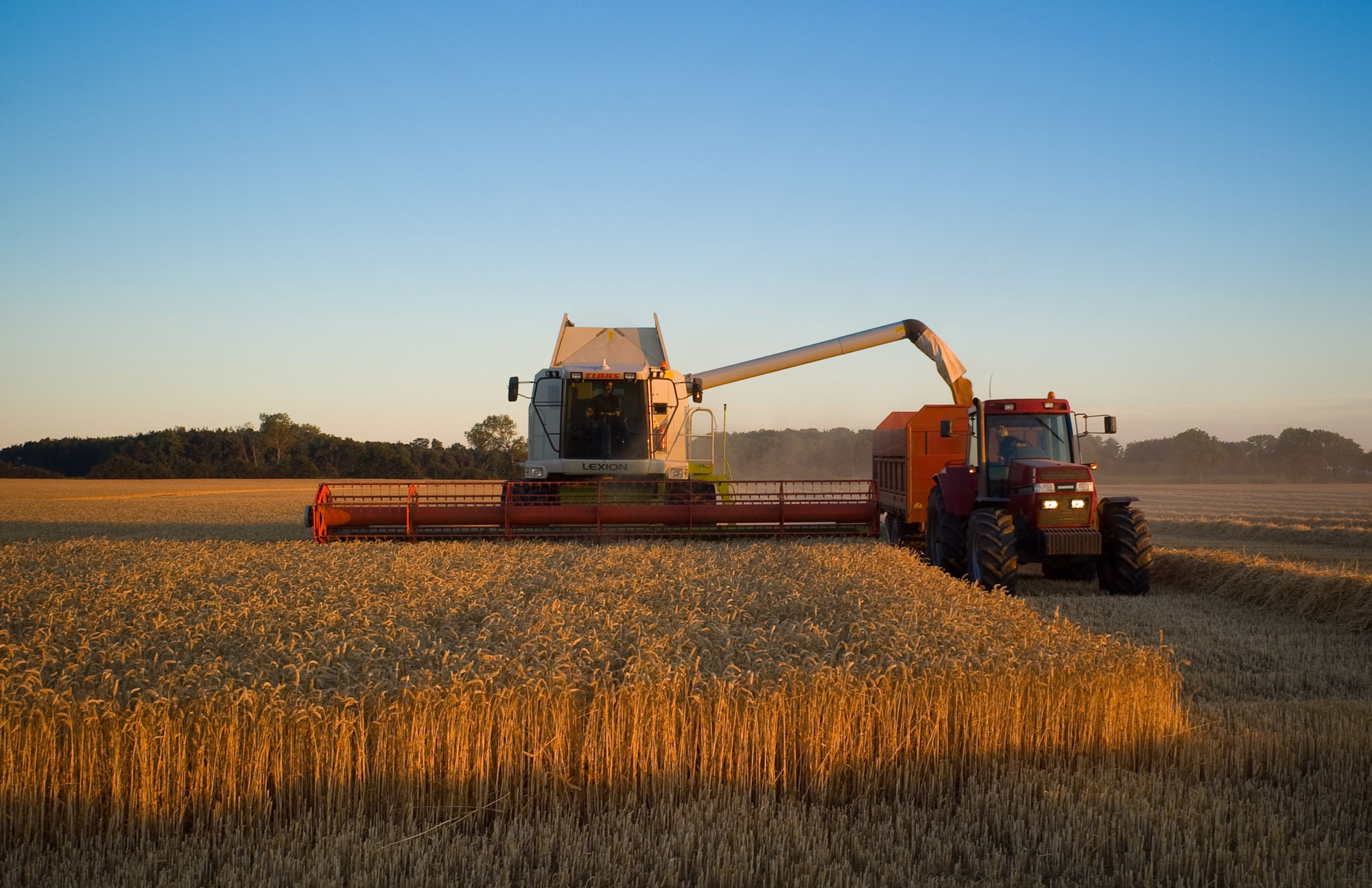
A combine harvesting wheat, which is being loaded into a trailer pulled by a tractor. Mechanized harvest would be difficult or impossible without synchronous ripening of the crop. Photo by Lars Ploughmann (flickr, Creative Commons Attribution-ShareAlike 2.0 Generic license, image resized).
Seed dispersal
Many wild grasses have inflorescences or ears (groups of flowers or fruits) that shatter when the fruits are mature. Shattering inflorescences (or brittle inflorescences) break apart naturally at weak points, helping wild grasses to scatter and spread their seeds.
The potential drawback of shattering in domesticated cereals is obvious: shattering means that much of the grain may be lost before or during harvesting. Many domesticated grasses grown for their grains have non-shattering (or non-brittle) inflorescences even if their wild ancestors had shattering inflorescences. For example, the wild relatives of barley, einkorn wheat, emmer wheat, maize, oats, and sorghum all have shattering inflorescences, whereas the domesticated crops do not.
In some grasses, like wild wheat and oats, the spikelets have awns (extensions on the bracts) or other projections that help the spikelets disperse and/or drill into the ground. In oats, the twisted awns that help the spikelets crawl over and drill into the ground have been lost in domesticated plants.
Video showing oat spikelets dropping off oat plants and dispersing using their awns. Video: "These seeds can walk!" from The Green Planet, BBC Earth on YouTube.
Grain size
Grains of cereal crops have been modified to be larger than their wild counterparts. The reason for this is clear: the larger the grain, the more calories it can provide, and the less effort expended per calorie to harvest and process.
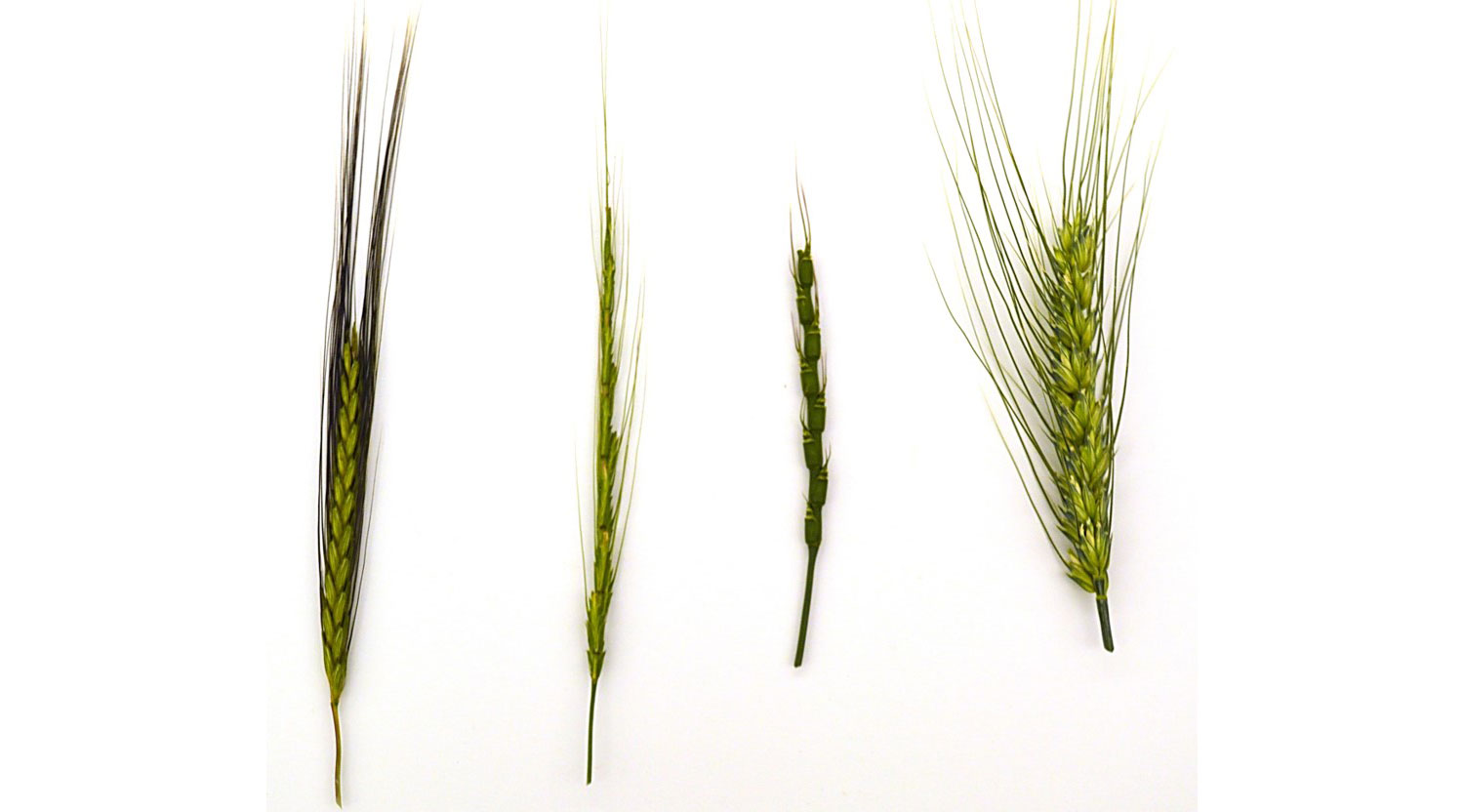
Bread wheat and its ancestors, showing differences in the sizes of the grains. From left to right: Red wild einkorn wheat (Triticum urartu), goatgrass (Aegilops speltoides var. ligustica), Tausch's goatgrass (Aegilops tauschii), and bread wheat (Triticum aestivum). Photo by Pat Byrne (from G. M. Volk and P. F. Byrne, Crop wild relatives and their use in plant breeding. Colorado State University, eBook, public domain).

Goatgrass (Aegilops speltoides), one of the ancestors of bread wheat (Triticum aestivum). Photo by Jose Hernandez (USDA-NRCS PLANTS Database).
Ease of processing
Grains of many cereal crops have been modified to make them easier to process. Some domesticated cereals have been selected for free-threshing grains. For example, the first domesticated wheats, like einkorn and emmer wheat, had hulled grains. Wheats in wide cultivation today, like durum wheat and bread wheat, have free-threshing grains. Barley and oats also have hulled and free-threshing forms.
Other grains were modified in other ways. Maize, in particular, is high modified from its wild relatives, called teosinte. In teosinte, the grains are surrounded by hard fruitcases (hard coverings or shells). Maize grains do not have hard fruitcases, so the grain used after it is removed from the ear and cleaned.

Teosinte kernels. Photo by Michael Chauvet (Wikimedia Commons, Creative Commons Attribution-ShareAlike 3.0 Unported license, image resized).
List of cereals
The table below provides the common names of cereals crops, their scientific names, their places of origin or original domestication, and the areas where they are primary cultivated today. Note that there is some debate about the appropriate scientific name to use for some grains, and the table does not include all common names. This table omits some wheats (for example, club wheat and Polish wheat), which are either recognized as subspecies of rivet and bread wheats or are elevated to their own species.
| Common name | Scientific name | Place of origin | Primary areas where cultivated today |
|---|---|---|---|
| Adlay, adlay millet, Job's tears | Coix lachryma-jobi | Southeast Asia? | Tropics |
| African rice | Oryza glaberrima | West Africa | West Africa |
| Barley | Hordeum vulgare | Middle East | Cultivated widely |
| Black fonio, fonio millet, iburu | Digitaria iburua | West Africa | West Africa |
| Bread wheat, common wheat | Triticum aestivum or Triticum aestivum ssp. aestivum | Middle East | Cultivated widely |
| Browntop millet | Brachiaria ramosa | South Asia | South Asia |
| Durum wheat, hard wheat, macaroni wheat | Triticum durum or Triticum turgidum ssp. durum | Middle East | Cultivated widely |
| Einkorn wheat | Triticum monococcum | Turkey | Caucasus region, Europe, Morocco, Turkey |
| Emmer wheat, farro | Triticum dicoccum or Triticum turgidum ssp. dicoccum | Turkey | Caucasus region, Europe, Morocco, Turkey |
| Ethiopian oats | Avena abyssinica | Ethiopia | Ethiopia |
| Finger millet, ragi | Eleusine coracana | Ethiopia, Uganda | Africa, South Asia, China |
| Foxtail millet, birds food millet, African millet | Setaria italica | China | South and East Asia |
| Guinea millet | Brachiaria deflexa | Africa, Arabian Peninsula, South Asia | Guinea |
| Indian barnyard millet, sawa millet | Echinochloa frumentacea | India | Africa, South Asia |
| Japanese barnyard millet | Echinochloa esculenta | East Asia | East Asia |
| Kodo millet | Paspalum scrobiculatum | India | Africa, India |
| Little millet, sama | Panicum sumatrense | India | South and Southeast Asia |
| Maize, corn | Zea mays | Mexico | Cultivated widely |
| Manchurian wild rice | Zizania latifolia | China | China (mostly grown as a vegetable crop) |
| Oat, common oat | Avena sativa | Iberian Peninsula/North Africa or Middle East | Cultivated widely |
| Pearl millet, bulrush millet, cattail millet | Cenchrus americanus | Africa | Africa, India |
| Proso millet, broomcorn millet, common millet | Panicum miliaceum | Central Asia? | Asia |
| Rice, Asian rice | Oryza sativa | East Asia | Cultivated widely |
| Rivet wheat, poulard wheat | Triticum turgidum or Triticum turgidum ssp. turgidum | Middle East | Middle East, Europe, Pakistan |
| Rye | Secale cereale | Middle East | Cultivated widely |
| Sorghum, great millet, milo | Sorghum bicolor | Subsaharan Africa | Africa, India, Middle East |
| Spelt | Triticum spelta or Triticum aestivum ssp. spelta | Eurasia | Europe, North America |
| Teff, tef millet | Eragrostis tef | Eritrea, Ethiopia | Eritrea, Ethiopia |
| Timopheev's wheat | Triticum timopheevii | Middle East and Transcaucasia | Georgia |
| Triticale | xTriticosecale | Man-made wheat-rye hybrid | Australia, China, Europe, Russia |
| White fonio, fonio millet, hungry rice | Digitaria exilis | West Africa | West Africa |
| Wild rice | Zizania aquatica and Zizania palustris | Canada, U.S.A. | Often collected from the wild, cultivated in North America (California, Minnesota) |
Resources
Websites
Food Fortification Initiative: https://www.ffinetwork.org/
Lodging control in grasses (Oregon State University): https://blogs.oregonstate.edu/seedproduction/2012/05/03/lodging-control-in-grass-seed-crops/
Pellagra (Cleveland Clinic): https://my.clevelandclinic.org/health/diseases/23905-pellagra
What is nixtamalization? (CIMMYT, International Maize and Wheat Improvement Center): https://www.cimmyt.org/news/what-is-nixtamalization/
Articles
Peres, T. M. 2016. Malnourished: Cultural ignorance paved the way for pellagra. Gravy, Fall 2016. https://www.southernfoodways.org/malnourished-cultural-ignorance-paved-the-way-for-pellagra/
Books
Levetin, P., and D. S. McMahon. 2016. Plants and Society, 7th ed. McGraw Hill Education, New York.
Simpson, B. B., and M. C. Ogorzaly. 2001. Economic botany, plants in our world, 3rd ed. McGraw Hill Higher Education, New York, New York.
Evert, R. F., and S. E. Eichhorn. 2013. Raven Biology of Plants, 8th ed. W.H. Freeman and Company Publishers, New York, New York.
Volk, G. M., and P. F. Byrne. Crop wild relatives and their use in plant breeding. Colorado State University, eBook. https://colostate.pressbooks.pub/cropwildrelatives/front-matter/crop-wild-relatives-and-their-use-in-plant-breeding/
Scientific and technical articles
Alonso, N., F. J. Cantero, R. Jornet, D. López, E. Montes, G. Prats, and S Valenzuela. 2014. Milling wheat and barley with rotary querns: the Ouarten women (Dahmani, Kef, Tunisia). AmS-Skrifter 24: 11-30.
Arnold, D. 2010. British India and the "beriberi problem," 1798-1942. Medical History 54: 395-314. https://doi.org/10.1017/s0025727300004622
Ayalew, H., T. T. Kumssa, T. J. Butler, and X.-F. Ma. 2018. Triticale improvement for forage and cover crop uses in the southern Great Plains of the United States. Frontiers in Plant Science 9: 1130. https://doi.org/10.3389/fpls.2018.0
Brouns, F., Y. Hemery, R. Price, and N. M. Anson. 2012. Wheat aleurone: Separation, composition, health aspects, and potential food use. Critical Reviews in Food Science and Nutrition 52: 553-568. https://doi.org/10.1080/10408398.2011.589540
Food Security Department. 1999. Sorghum: Post-harvest operations. Food and Agriculture Organization of the United Nations. PDF: https://www.fao.org/fileadmin/user_upload/inpho/docs/Post_Harvest_Compendium_-_SORGHUM.pdf
Goron, T. L., and M. N. Raizada. 2015. Genetic diversity and genomic resources available for small millet crops to accelerate a New Green Revolution. Frontiers in Plant Science 6: 157. https://doi.org/10.3389/fpls.2015.00157
Kajuna, S. T. A. R. 2001. Millet: Post-harvest operations. Food and Agriculture Organization of the United Nations. PDF: https://www.fao.org/fileadmin/user_upload/inpho/docs/Post_Harvest_Compendium_-_MILLET.pdf
Marshall, A., S. Cowan, S. Edwards, I. Griffiths, C. Howarth, T. Langdon, and E. White. 2013. Crops that feed the world 9. Oats-a cereal crop and livestock feed with industrial applications. Food Security 5: 13-33. https://doi.org/10.1007/s12571-012-0232-x
Mejía, D. 2003. Maize: Post-harvest operation. Food and Agriculture Organization of the United Nations. PDF: https://www.fao.org/fileadmin/user_upload/inpho/docs/Post_Harvest_Compendium_-_MAIZE.pdf
National Research Council. 1996. Lost crops of Africa: Volume I: Grains. National Academy Press, Washington, D.C. https://doi.org/10.17226/2305
Nesbitt, M., and D. Samuel. 1995. From staple crop to extinction? The archaeology and history of the hulled wheats. Pp. 40-99 in S. Padulosi, K. Hammer, and J. Heller, eds. Hulled Wheat. Promoting the Conservation and use of underutilized and neglected crops 4.
Zohary, D., M. Hopf, and E. Weiss. 2012. Domestication of plants in the Old World: The origin and spread of domesticated plants in Southwest Asia, Europe, and the Mediterranean Basin, 4th ed. Oxford University Press, UK. https://doi.org/10.1093/acprof:osobl/9780199549061.001.0001



